Tour South Korea in three weeks by car and visit the lesser-known south and west with this travel itinerary. You’ll see Ganghwa, Namwon, Wando and more. If you are looking for a well-balanced mix of big cities, culture and nature, while skipping the so-called ‘highlights’ then this travel itinerary is for you.
This trip is ideal for second-time visitors that have already seen the highlights of South Korea. If this is your first visit to South Korea, you might want to check my other South Korea travel itinerary featuring the highlights and must-see places for first-time visitors.
Travel itinerary overview
- Ganghwa – day 1 – 2
- Chuncheon – day 3 – 5
- Chungju – day 6 – 7
- Daegu – day 8 – 9
- Namwon – day 10 – 12
- Boseong – day 13 – 14
- Wando – day 15 – 16
- Mokpo – day 17 – 18
- Boryeong – day 19 – 20
- Suwon – day 21
- Practical information (including detailed travel budget information)
If you have more time, you can add some days in Seoul at the end of this itinerary
Use this itinerary if you want a comfortable trip. It’s not a quick see-it-all, but a well-balanced itinerary using one city as a base for exploring the area.
Check out my Lesser-known south and west of South Korea Itinerary map in Google maps.
Ganghwa - day 1 - 2
Ganghwa is only a 30-40 minute drive from Incheon airport. The island, connected to the mainland by bridges, played a key role in opening Korea to the world. From the northern tip of Ganghwa, you can see North Korea.
Day 1 - North Ganghwado and Gyodong
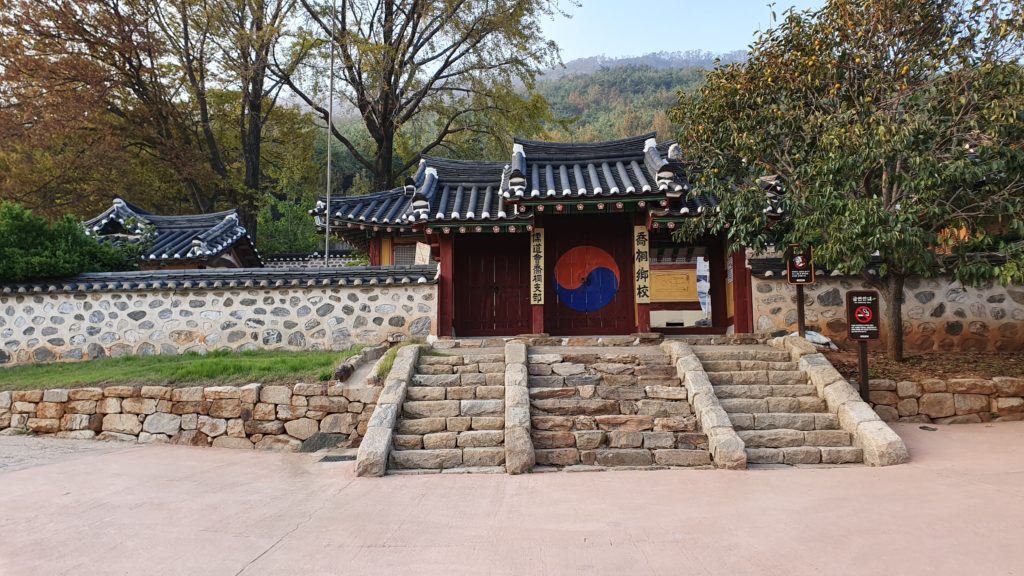
The first day of this mid and west South Korea journey is perfect for a road trip on the islands of Ganghwa and Gyodong. There are many historic sites originally used in the defense of Ganghwa and Korea. You probably don’t want to visit all of them and instead choose to spend more time at some of the sites to also enjoy the area surrounding it.
Visit (one of) the fortresses Deokjinjin (mid), Gwangseongbo (north) and Chojijin (south). If you only have time for one I suggest you visit Deokjinjin as it has a gate, cannon defense and a fort and then drive north to Ganghwa Fortress’ four gates. In the middle, you can also see an Anglican Church (in Hanok style!) and Yongheunggung Royal Residence, so this is a good area for sightseeing and having a drink in a cafe.
Next up is Ganghwa Dolmen; a well-advertised place where you can see a dolmen. Skip this if you want to win some time (or simply take a picture of the dolmen from beyond the gate). There is a more interesting dolmen site further south that you can visit on day 2 of this itinerary.
If you like museums you can visit Hwamunseok Cultural Centre to learn more about how the people of Ganghwa lived long ago.
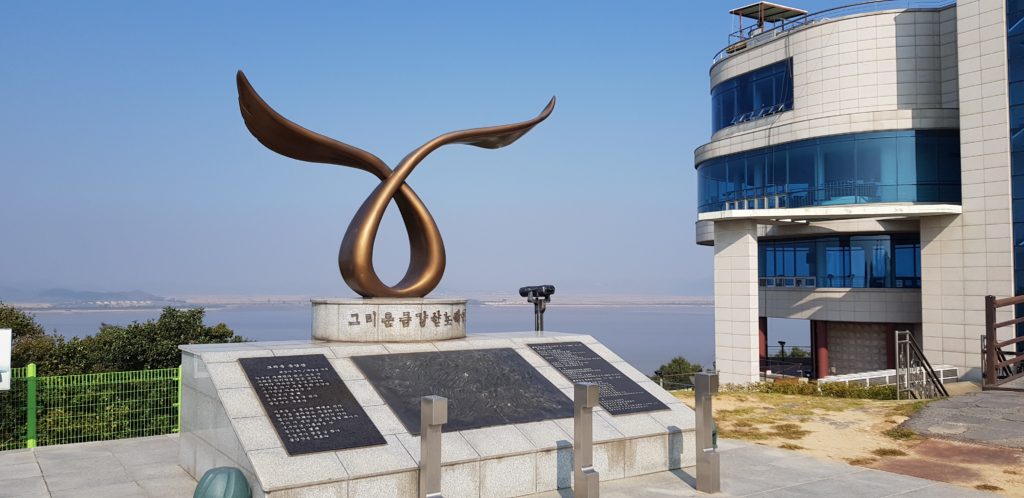
Drive further north on one of the smaller roads for a nice view of the rice fields and farms until you get to Ganghwa Peace Observatory at the northernmost part of the island to look at North Korea with binoculars. On your way to the observatory, you have to check-in at an army post to receive your visitor card and return it to the same army post on the way back. When we got there the soldiers were very excited to see some foreigners.
When entering Gyodong you also have to pick up a visitor card at an army post. Another interesting fact: whenever you enter Ganghwa from Gimpo, your car gets an anti-epidemic car wash. Motorcyclists too!
After visiting the Ganghwa Peace Observatory, drive west to the smaller island Gyodong for a drink in Gyodong-myeon, another look at North Korea at Gyodong Observatory (meaning two wild binoculars) and a visit to Gyodong Hyanggyo, a beautiful sight without any tourists. Even Google hasn’t filmed the roads yet, so enjoy the sight. If you want a sneak preview, check out this area in KakaoMap.
Read more about the must-see places on Ganghwa, Gyodong and Seokmodo
Day 2 - South Ganghwa and Seokmodo
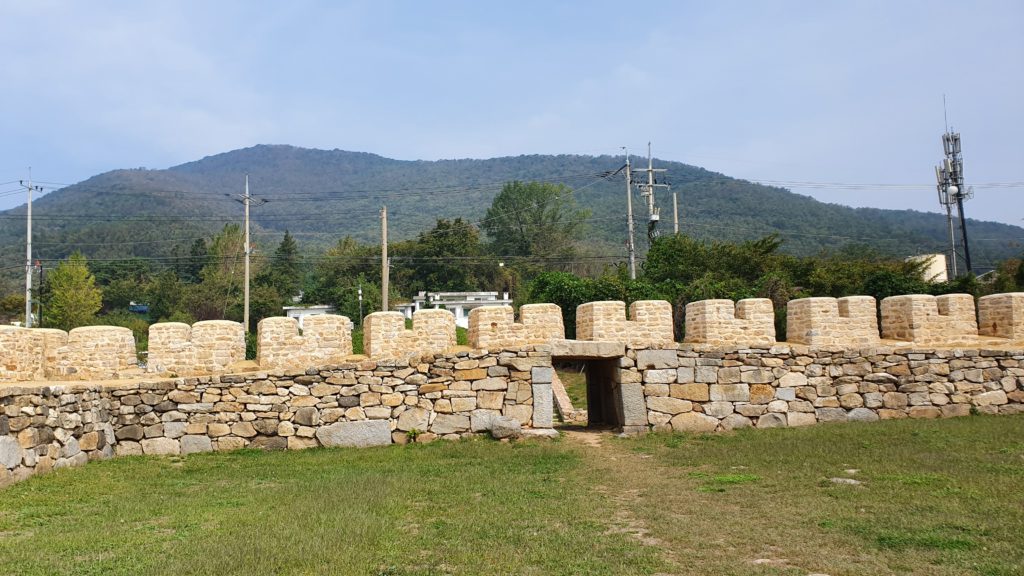
Visit Jeondeungsa Temple in the southern part of Ganghwa for a walk around the temple grounds and some traditional tea with a rice cake mugwort snack. If you feel active you can walk up the stairs near the entrance of the temple to get a nice view of the island and the temple grounds from above.
After your visit to the temple, head south for a quick stop at Huaedondae fort and a view of the ocean mud.
From there, drive to Seongmodo / Seokmodo, another island with sights not yet spoiled by Google Maps (it’s even keeping the bridge linking Seokmodo and Ganghwa secret). Use KakaoMap for a more recent view of the island.
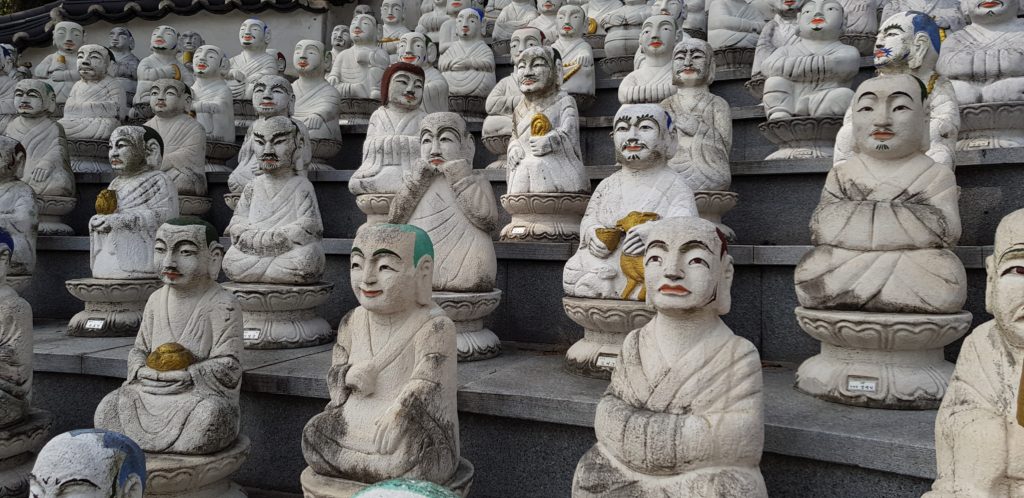
On the island, you can see Bomunsa temple and go for a walk in the Seokmodo Arboretum. After returning to Ganghwa island, make a quick stop at the lesser-known dolmen and gravesite in the middle of the island. Also nearby is Ganghwa Arimae World; a museum about agriculture for kids but also very interesting for adults as you can learn more about the fruit and plants grown on Ganghwa. The museum is in Korean but with many pictures making it easy to understand.
Alternatively, you can hike up to Chamseongdan Altar on Ganghwa for a nice view of the whole island.
Where to stay in Ganghwa
I chose Docking Hotel just across the bridge from Ganghwa (so in Gimpo actually) because of its location, closeness to restaurants and good price. The hotel itself was ok but had just changed owner and now only accepts cash. Also, the location on Agoda isn’t accurate (it is actually a 5-minutes drive further east) and it took some time to find the hotel.
Chuncheon - day 3 - 5
Chuncheon is a popular getaway for those looking to spend a day outside the bustling capital of Seoul. It is known as the city featured in the Korean TV drama Winter Sonata.
Day 3 - Paju Book City, Nuri Peace Park, Soyanggang sidewalk, Chuncheon Myeongdong street
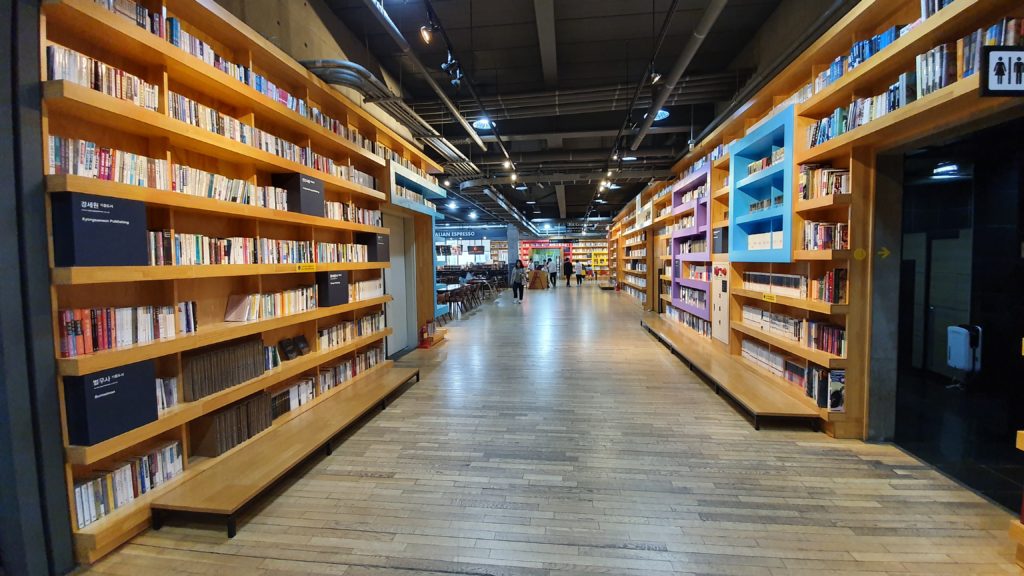
Before going to Chuncheon, make a quick stop at Paju Book City. Have a drink in one of the cafes while looking at shelves full of books. If you’re up for another “border with North Korea” experience, head north past Paju to visit Nuri Peace Park to enjoy the park and contemplate war and peace while watching art.
From there drive east and enjoy the mountain road when you continue to Chuncheon after visiting the waterfall. Explore Chuncheon in the evening and visit Soyanggang sidewalk for a nice view of the city and lake. For dinner, head to Myeongdong street to try the Dakgalbi Chuncheon is famous for.
Day 4 - Nami Island, Petite France, Garden of Morning Calm
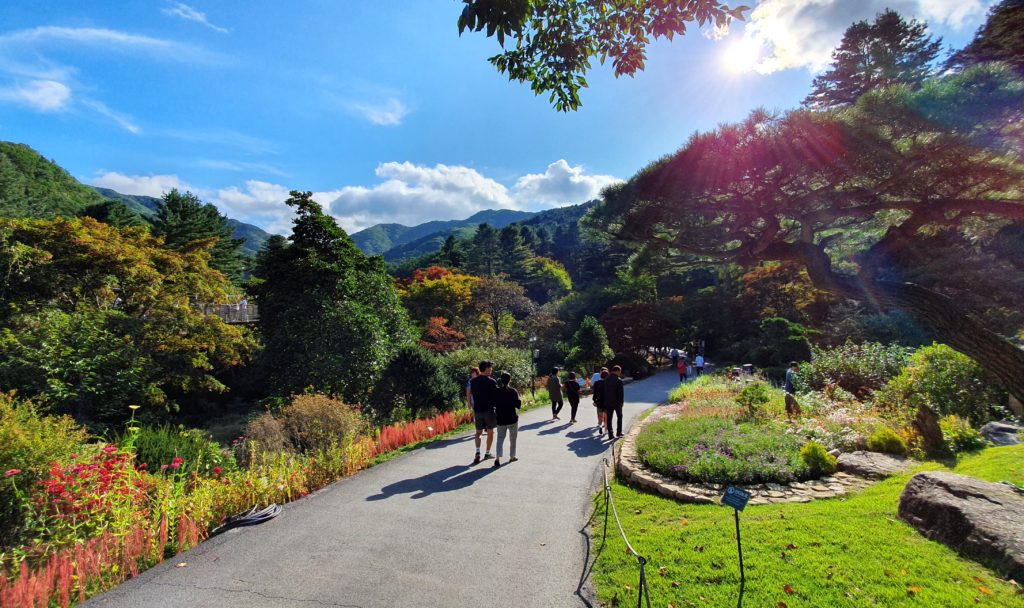
Today’s sightseeing starts at Nami Island, only a short drive from Chuncheon. Park your car at the ferry parking lot northwest of the island and take a short ferry ride to Nami. On the island, famous from the Korean TV Drama Winter Sonata, you can take a stroll along the tree-lined boulevard and grab something to eat or drink.
After your visit to Nami, take the ferry back to your car and drive over to Petite France, which has been used as a film set for many tv shows as well (example: My Love from Another Star). I skipped this stop as I was a bit pressed for time and because I can actually drive to France from my hometown. For this same reason, I skipped Huis ten Bosch (Little Holland) near Nagasaki last year.
The next stop is the Garden of Morning Calm, a beautifully designed garden in a valley surrounded by mountains. You can see blooming flowers in spring or summer, autumn leaves in fall or snowy landscape in winter. If you’re visiting in winter it’s worth going there at night as the whole garden will be illuminated: a true winter wonderland.
Day 5 - Yanggu, Unification Hall, Eulji Observatory, Hwacheon Peace Dam, Gubongsan Observatory
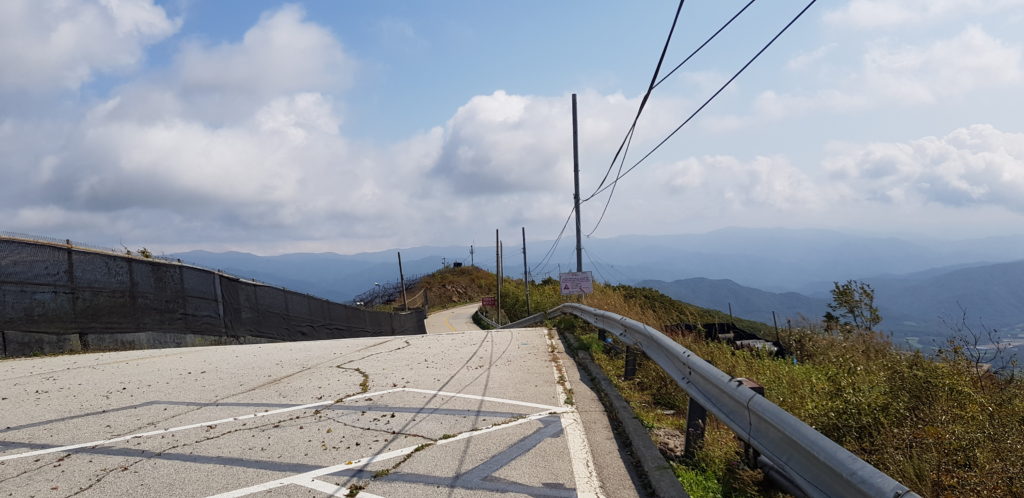
It’s time for a road trip again. Drive northeast of Chuncheon towards Yanggu Rodeo street; a street decorated with art though in a very smalltown way.
From there on drive further north along the mountain road to Eulji Observatory. Eulji Observatory is located at the ridge of Gachilbong Peak at only 1km from the DMZ. The 4th Infiltration Tunnel is nearby. From the observatory, you can see the Punchbowl (bowl-shaped Haean basin). Make sure you reach the observatory in time as the last admission is 16:00 in winter and 17:00 in summer. You’re not allowed to enter the 4th Infiltration Tunnel during lunch time (12:00 – 13:00). Also keep in mind that times may change and the tunnel might close because of the weather (like a tornado; this happened to me but luckily I checked the website the day before and could change my itinerary). A visit to the observatory and tunnel is only possible by car or organized tour; no bicycles or motorcycles allowed.
Before you can visit the tunnel and observatory you need to stop by Unification Hall to register your visit. They will give you a blue paper for access to Eulji Observatory and a yellow and pink paper for the 4th Infiltration Tunnel. Make sure you don’t hand in your yellow or pink paper at Eulji Observatory (that happened to us: the soldier at the guard post wouldn’t let us leave with our yellow paper) or you’ll have to get a new one at the Unification Hall before visiting the Tunnel.
You can also visit Eulji Observatory as a day trip from Sokcho.
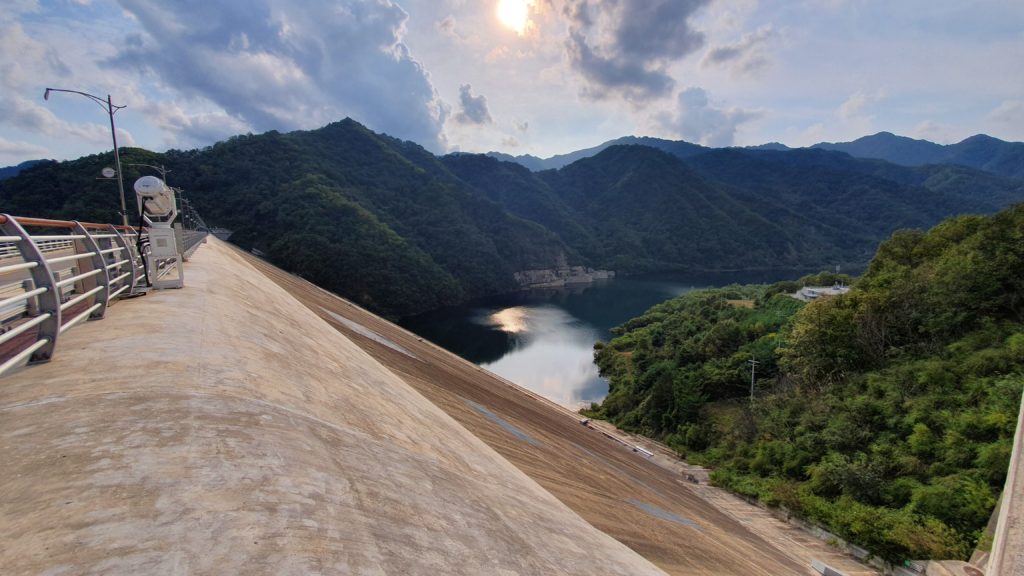
Continue the roadtrip west towards Hwacheon and stop at the Peace Dam to strike the peace bell (the tourist guides at the information stand will help you) and enjoy the view on top of the dam.
From there, head back to Gubongsan Observatory in Chuncheon to watch the sunset.
What to read in Chuncheon
On days 3 and 5 you visit the border with North Korea. So my reading recommendation for this part of the trip is:
Masaji Ishikawa - A River of Darkness: One Man’s Escape from North Korea
About the treatment of someone stuck between two worlds. It makes you want to fix the world, but just like the main character, you probably won’t be able to do anything about it.
Half-Korean, half-Japanese, Masaji Ishikawa has spent his whole life feeling like a man without a country. This feeling only deepened when his family moved from Japan to North Korea when Ishikawa was just thirteen years old, and unwittingly became members of the lowest social caste. His father, himself a Korean national, was lured to the new Communist country by promises of abundant work, education for his children, and a higher station in society. But the reality of their new life was far from utopian.
Interested? Get your copy from Amazon.
Where to stay in Chuncheon
I stayed at OST Hotel in the middle of Chuncheon near Myeongdong street and shops because of its good location and price. I can recommend this hotel as a low budget option.
Chungju - day 6 - 7
Chungju is a beautiful town with hot springs surrounded by National Parks.
Day 6 - National Park, Hot spring bath
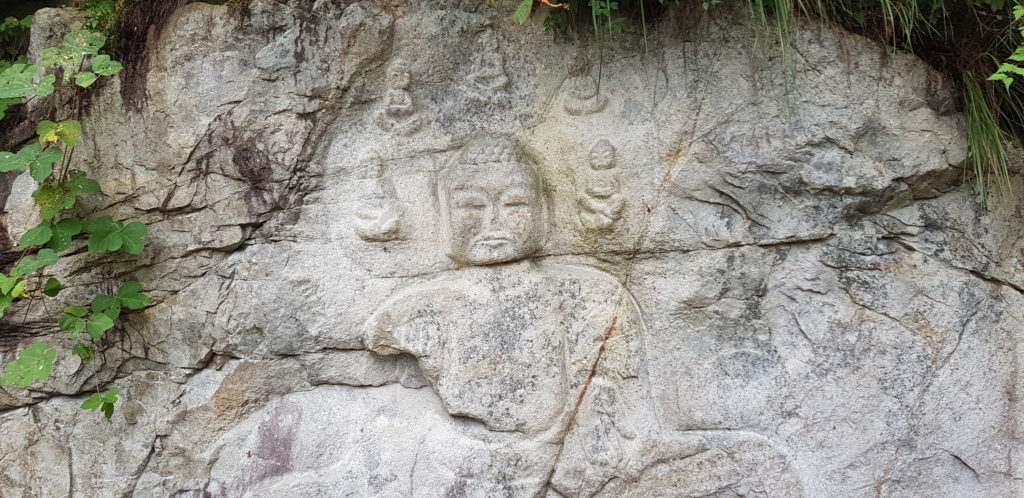
As Chungju is not far from Chuncheon, there is plenty of time today to visit one of the national parks. Take your pick from Chiaksan National Park, Songnisan National Park, Woraksan National Park or Sobaeksan National Park. Tomorrow you can visit one of the others.
If you’re looking for an easy and short trail, head over to Songnisan for a short hike and lunch near the trail.
Enjoy a hot spring bath in your hotel or one of the spas in the evening.
Alternative options if you don’t want to go hiking in a national park:
About half an hour northwest of Chungju, you can find the Rock-carved buddhas of Bonghwang-ri. In the middle of nowhere, in a quiet village surrounded by farms, you can find this small and unknown point of interest. After climbing a few stairs, which takes only a few minutes, you reach the stone buddha’s carved in the rock. The remote location and the quiet nature of the area make this a very good place for a small altar.
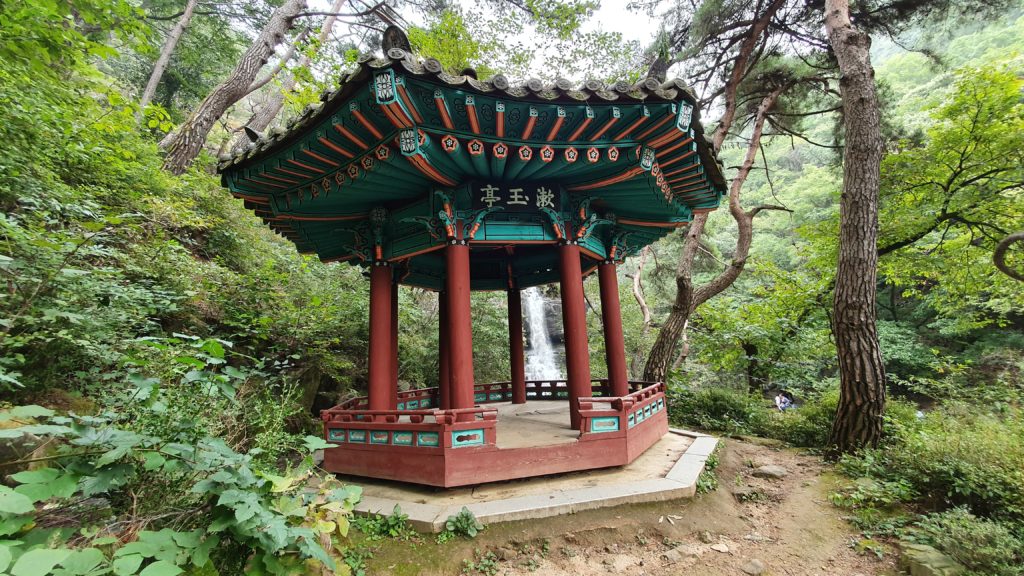
Closer to Chungju you can visit two parks: Jungangtap Historic Park and Chungju Tangeumdae. We chose to go to Tangeumdae, meaning ‘a rock platform for playing the gayageum’, associated with the musician Ureuk who would play the gayageum at this site. From the park, you have a good view of the river and many sculptures and memorial pagodas can be seen on a walk through the park.
Right next to Tangeumdae (but below the hill) you can find Chungju World Martial Arts Park which is often used for festivals. During my visit on 5 October, the Chungju Agricultural Products Hanmadang Festival was held allowing us to try many local specialties (it was tiny apple and sweet potato season apparently). So if you’re visiting in early October, keep an eye on this festival (충주농산물 한마당 축제).
South of Chungju lies Suok Pokpo Falls; a beautiful waterfall with a pavilion that is easily reached from the nearby parking lot. Photo tip: stand next to the pavilion to take a picture of both the waterfall and the pavilion.
Day 7 - Cheongpung Cable Car, Dodamsambong Peaks, Guinsa Temple
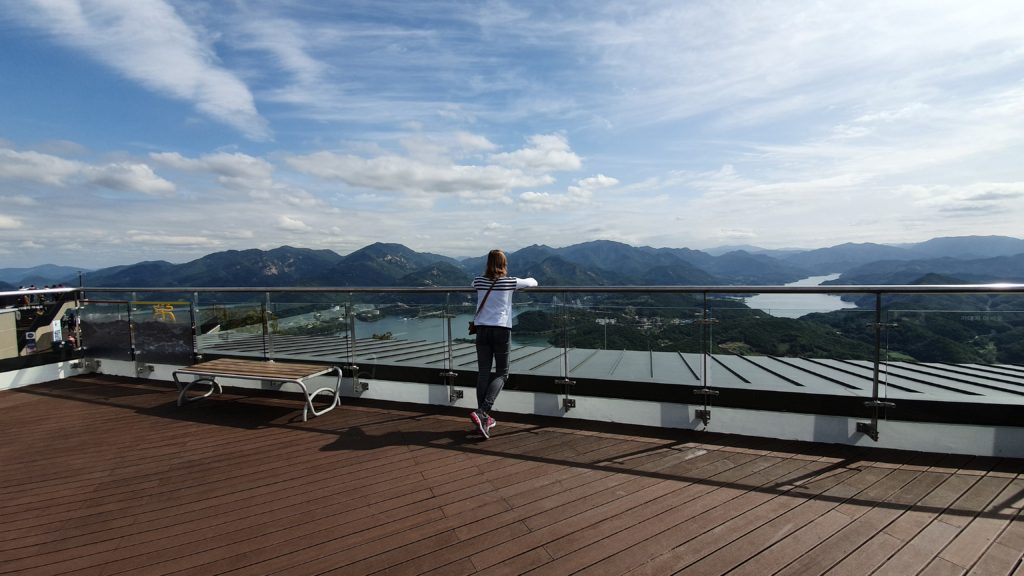
Start the day with a beautiful drive from Chungju or Suanbo along road 508 through Woraksan National Park to get to Cheongpung Cable Car. From the top of the cable car platform, you can see Jecheon lake and the surrounding mountains. In the cafe and bakery on top, you can have a coffee break while still taking in this fantastic view. If I ever return to this area, I’ll definitely take the cable car (one of the best in South Korea) to the top again to spend some more time on the platform.
Drive east from Cheongpung to Danyang to see Danyang’s Dodamsambong Peaks; one of the eight views of Danyang. If the season is right you get this beautiful view of the three rocks and pavilion with a colorful flower field in front.
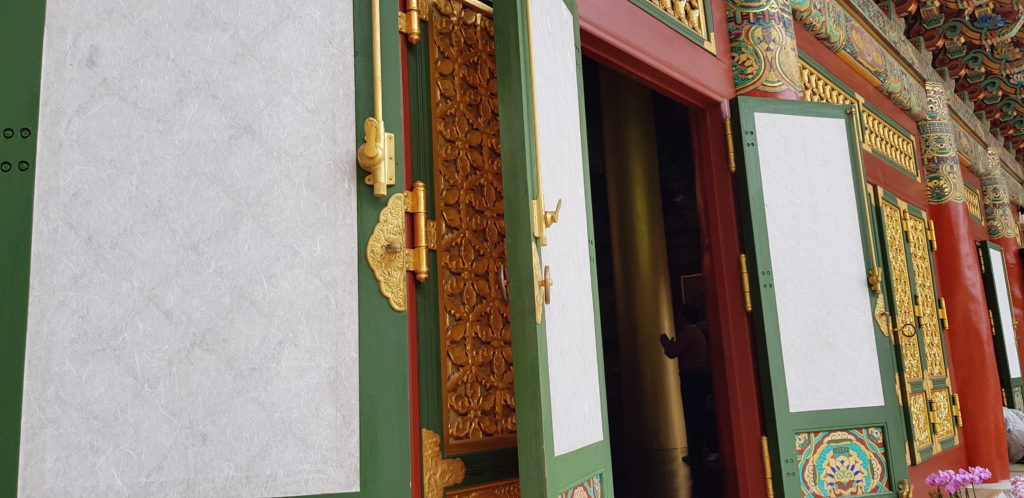
The next stop is Guinsa Temple, one of the most incredible temples of South Korea. From the temple, after reaching the top, you have a terrific view of the whole temple area surrounded by mountains. Be prepared to walk half an hour uphill to reach this top. On the way, you pass the temple stay buildings that were built in the same style. But the top, that’s where the real sights are.
Alternatively, you can skip the above and go hiking all day.
Where to stay in Chungju
I chose to stay at Hotel Screen in the Suanbo area of Chungju because it is surrounded by national parks and offers a hot spring bath.
What to watch when visiting Chungju

Svaha: The Sixth Finger
Interesting movie taking place in the Chungju area. There are many references to the buddhist centres in Chungju, Jecheon, Danyang, Jeongseon and Taebaek. The scenery is very nice to watch and gives you an idea of what the area looks like.
Description: Pastor Park works to expose suspicious religious groups. He’s hired to look into the cult group Deer Mount. Meanwhile, Police Captain Hwang investigates a murder case and the main suspect is a member of the Deer Mount cult.
The movie is available on Netflix (in my country).
Daegu - day 8 - 9
Day 8 - Mungyeong Fortress and Tunnel, Hamchang Art Road, Daegu
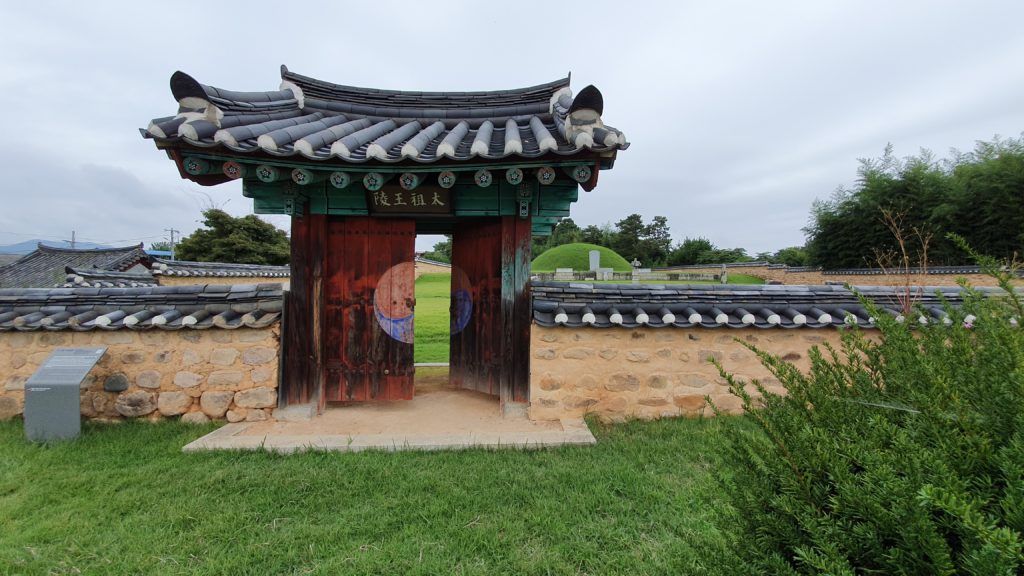
After many days in smaller cities and visiting national parks, it is time to enjoy the big and vibrant city Daegu. But before you go there, you will make some stops in small, lesser-known towns.
The first stop of today is Mungyeong to see Gomosanseong Fortress. This fortress has a beautiful location on top of a hill and gives a good view of the surrounding mountainous area and the river flowing in between. North of the fortress gate you can find an open-air traditional Korean houses ‘museum’ (more like three houses). Also nearby is Tokkibiri Cliffside Road, a famous trade route, that you can reach by following the fortress wall east.
Before heading back to your car, you can visit Mungyeong Omija Theme Tunnel near the parking lot to observe mural art and other artistic decorations in the tunnel.
The next stop is Hamchang to follow the Hamchang Art Road. This road leads you in a circle through the village, showing mural art (not that much) and other artistic expressions but more interestingly it shows you an authentic village (small town) in the countryside with nice houses. Start near Hamchang Train Station and follow the white line that has been edged into the street (it looks like someone spilled paint) through town.
On the road, you can also find Tomb of King Goryeong-Gaya (Gaya Royal Tomb): a not very touristic site but perhaps one of the most beautiful tombs I visited on this trip.
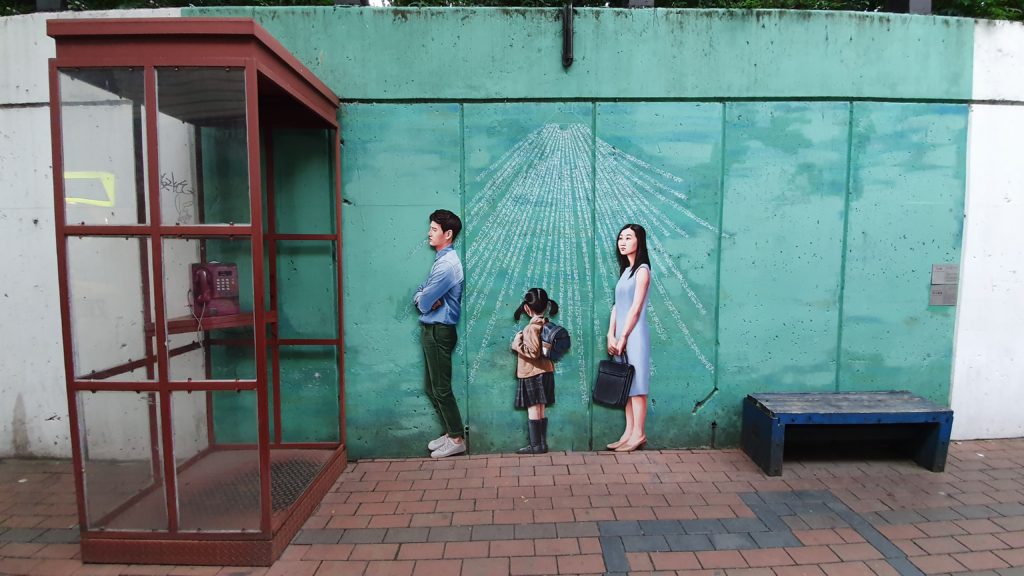
Continue to your hotel in Daegu and take the subway to Kim Gwang Seok Street: a street dedicated to the deceased singer Kim Gwang Seok. The whole street has been decorated with colorful (mural) art. Have a drink at one of the many cafes while enjoying the view.
When it gets dark it is the perfect time to explore the shopping area near Dongseong-ro and find a restaurant that serves Daegu Makchang (grilled intestines).
If you have some spare time during the day, you can also take the cable car up to Apsan Park and Observatory for a good view of the city and a hike.
Day 9 - Gyeongju
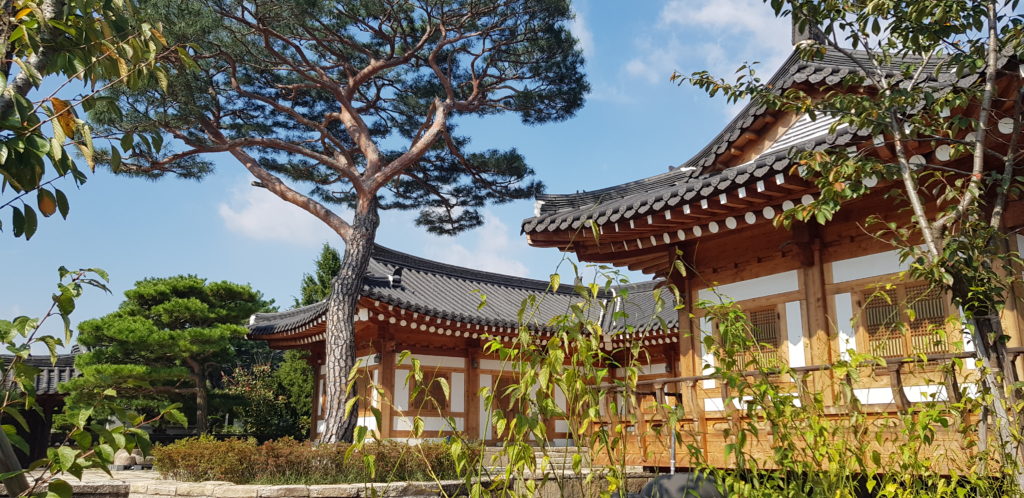
Today’s highlight is a day trip to Gyeongju. Alternatively, you can visit Andong, which I wrote about in my Highlights of South Korea itinerary. Gyeongju is often referred to as ‘the museum without walls’, due to the many archaeological sites in the area.
Start with a visit to Gyeongju’s Gyochon Traditional Village to observe traditional houses. If you visit out of season (and in my case on a Tuesday) many restaurants and attractions will be closed but you can still wander through the streets and watch the hanok houses. Parking tip: park at the parking lot to the left of the village for free parking. You have to pay for the parking spaces outside of the lot.
Next to the village, you can find Woljeonggyo Bridge, originally leading to Wolseong palace, a royal palace of the Silla dynasty.
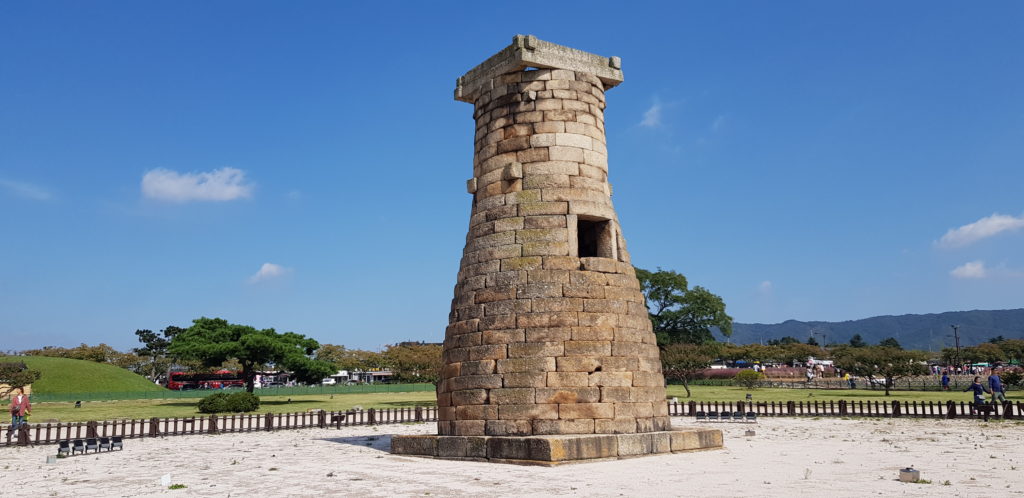
Walk north from the Woljeonggyo Bridge towards Cheomseongdae Observatory, the oldest surviving star-gazing platform in Asia. On your way, you can see Gyeongju Hwangnamdong remains on the left side.
Northwest of Cheomseongdae Observatory, you can visit Daereungwon Tomb Complex to see the Tomb of King-Michu and Cheonmachong. Also interesting here are the curved trees and fruit trees in the park.
East of Cheomseongdae Observatory you can visit Donggung Palace and Wolji Pond, the secondary palace used by the crown prince during the Silla period. During the Goryeo and Joseon period, the pond was referred to as Anapji Pond.
A fifteen minutes drive south of this historical site heavy area you can find Seochulji Pond, a site pretty much ignored by tourists and therefore blissfully quiet. The pond is at its best when the lotus flowers in the pond are in full bloom, but even if they are not the pond is worth a visit because of the lay of the land, the trees surrounding the pond and the buildings in the area.
If you have more time you can drive half an hour east to visit Bulguksa Temple and Seokguram Grotto.
When evening falls head back to your hotel in Daegu and visit one of the many restaurants in the city for a good meal.
Where to stay in Daegu
I stayed at an apartment (Dan Home), because I found one with a good price near a subway station I wanted to be close to (Banwoldang) and near a shopping and restaurant area.
Namwon - day 10 - 12
Day 10 - Jianjae Pass, Odogae Pass, Jirisanjomang Park, Changwon, Byeoksongsa Temple, Seoamjeongsa Temple
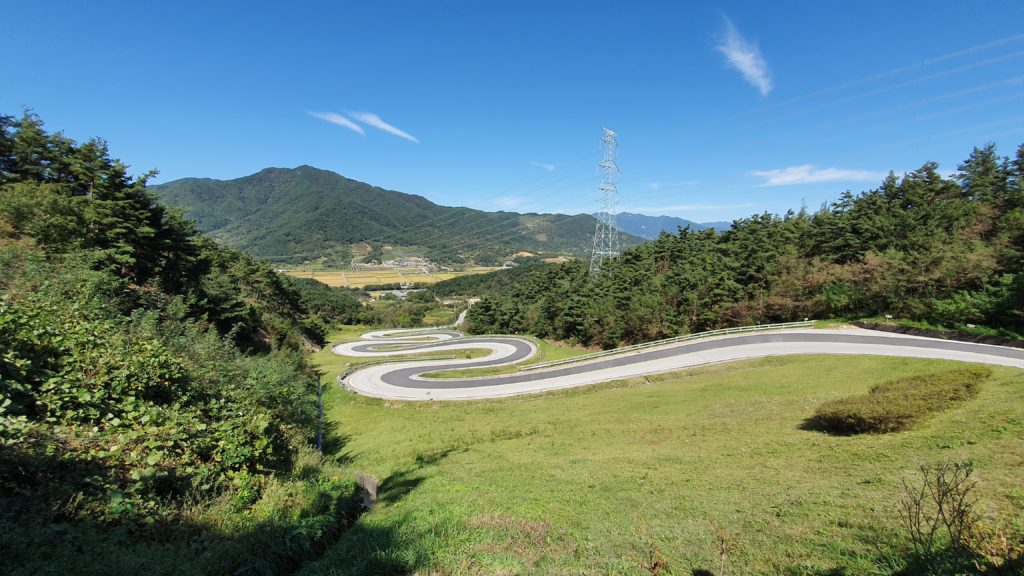
The next hotel in Namwon is within two hours driving distance from Daegu. But as there are many places to visit in the area, you can go sightseeing until evening falls.
Drive west to Hamyang and take the scenic drive along the Odogae Pass (or Jianjae Pass) into Jirisan National Park. The Odogae Pass was designated as one of the 100 most beautiful roads of Korea. Along the road, you can also the First Gateway and Jirisanjomang Park.
Head further south to visit the village of Changwon and have a drink at 마을카페안녕 (closed on Mondays).
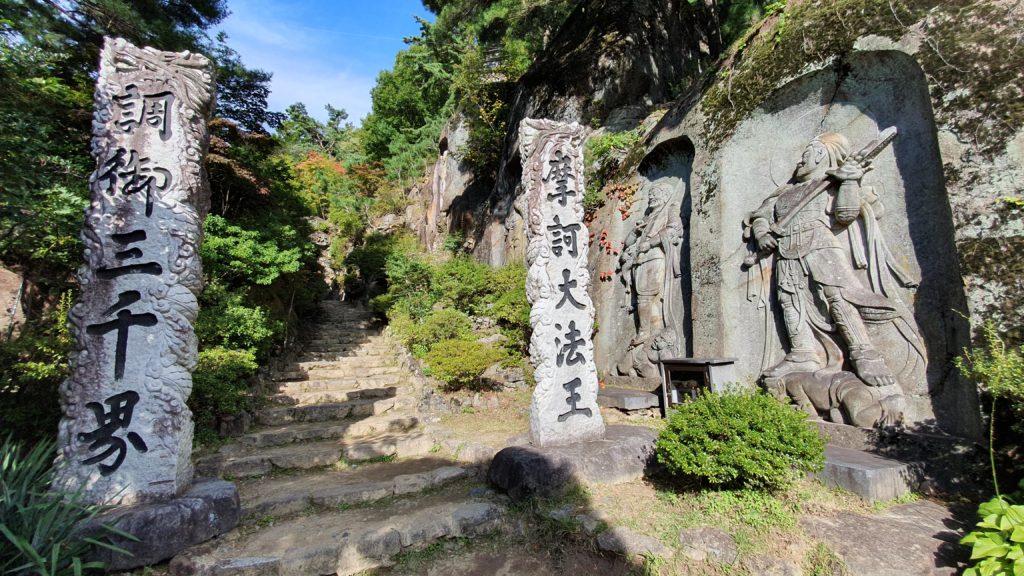
Drive further south to visit the secluded Byeoksongsa Temple. Walk to the top to have a great view of the temple site surrounded by mountains.
The next stop is Seoamjeongsa Temple. Of all the sites I visited during this South Korea itinerary, this was perhaps the site I was most impressed with because it was so beautiful. When you enter the area you walk past rock-carved guardians, between walls of stone until you reach very well-maintained temples surrounded by mountains. There is a cave with walls completely covered by rock-carvings. And so on. It is easily one of the most impressive temples in South Korea.
Parking tip: you can drive all the way to both temples if you visit out of season. Drive past the bigger parking lot with shops and go right for Byeoksongsa Temple (many parking spots) and left for Seoamjeongsa Temple (only five parking spots, so you have to be lucky).
From here, follow the mountain road until you reach your hotel in Namwon.
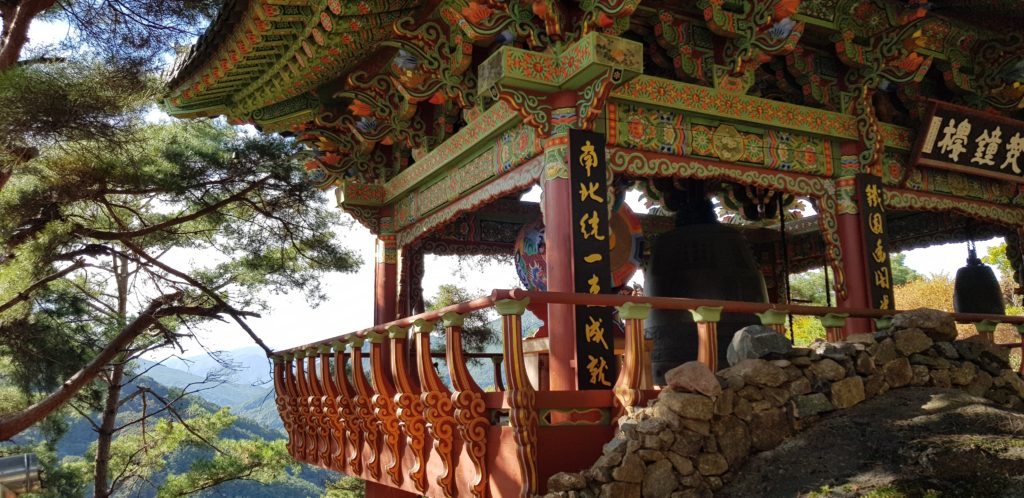
If you’re up early, you can also make the following stops before heading to Hamyang.
The first place to visit today is Miryang Man-Eosa to see the temple overlooking a field of black stones spread all the way down the mountain. Afterward, head into Miryang for a drink and a visit to Mubongsa and Yeongnamnu Pavillion overlooking the river around Sammun-dong.
Also near Miryang is Yerim Seowon; a school turned shrine. This site probably looks a lot like Dosanseowon near Andong, but is not as well-known.
From here, drive north to Haeinsa Temple in Gayasan National Park. This temple complex is surrounded by mountains so a visit is probably already worth it because of the road that takes you there.
Southwest of Gayasan National Park, you can visit Daebyeong-myeon to eat at a restaurant and take some pictures of the nearby lake.
Day 11 - Jinan Red Ginseng Spa, Maisan Provincial Park, Tapsa Temple
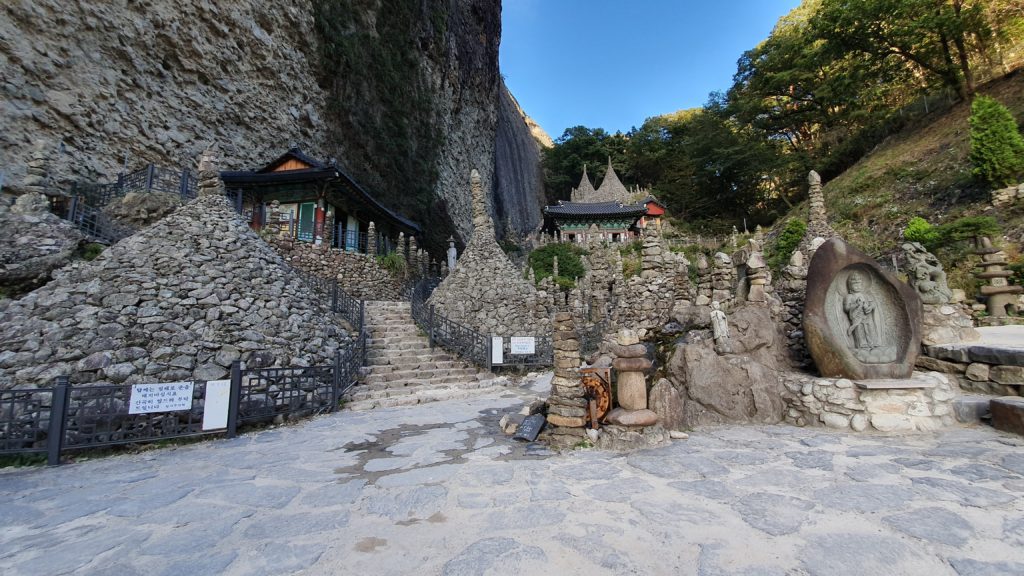
Head to Maisan Provincial Park to visit Tapsa Temple and Eunsusa. Both temples are located in a very scenic area. Eunsusa has one big oval ‘mountain’ behind it and Tapsa Temple is surrounded by many stones; both are good sites for a stroll and taking pictures. Can you spot all the buddhas and alcoves hidden at the temple site?
From the parking lot, you have to walk about twenty minutes to reach Tapsa Temple. But before you get there you first pass Geumdangsa Temple: a teaser for what’s to come.
If you feel active, you can also go hiking in Maisan Provincial Park.
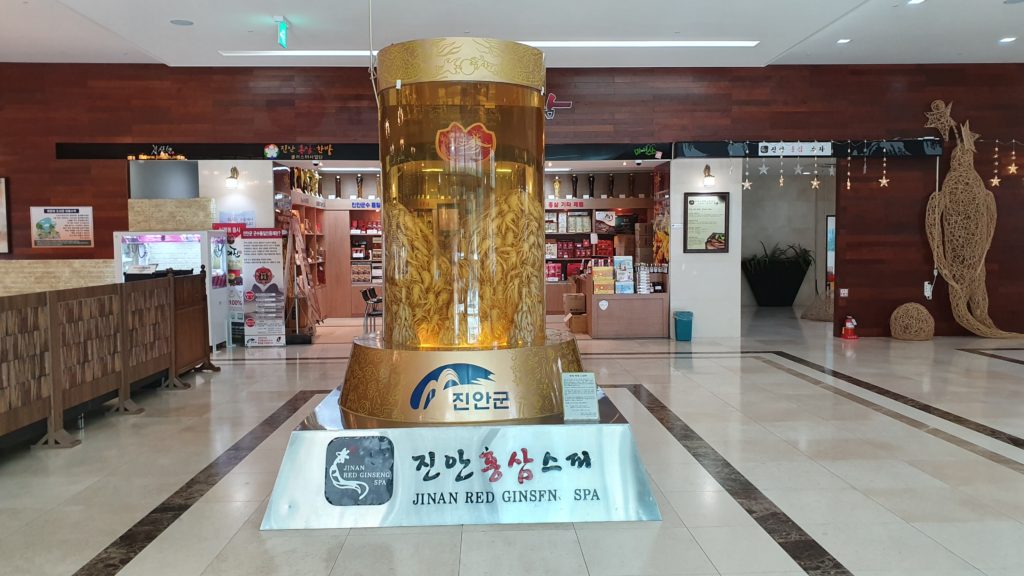
This afternoon is for relaxing at the Red Ginseng Spa in Jinan. After entering you follow the five-room program.
- The Harmony Therapy room: you smear yourself with mud and relax for ten minutes on the comfortable stone chairs until the showers start spraying water from the ceiling washing the mud off.
- The Stone Therapy room: lie down and relax for ten minutes on a bed of hot stones.
- The Aroma Therapy room: after drinking a red ginseng shot, you can lie down for fifteen minutes in a bubbling red ginseng bath using the herbal pillow provided.
- After drying in the hot-and-cold air room, you enter the Herbal Therapy room: you get to lie down for twenty minutes on a herbal/hay bed in a warm room. They actually forgot to get us out, so we were still there after 45 minutes… very relaxed of course.
- The Bubble Therapy room: come into contact with your inner child while playing with bubbles. You can completely cover yourself (or your companions) with eye-friendly soap. As in the Harmony room, you can wash it all off when the showers in the ceiling start spraying water.
After finishing the therapy rooms, or in between, you can visit the bubble bath on the rooftop, providing a great view of the two mountain tops of Maisan Provincial Park. Inside the spa, you can also enjoy the indoor room and the floating room.
The staff will help you get everywhere on time. To enter the spa you need a shower cap that you can rent at the reception desk. Towels are provided.
For pictures of the rooms, check out the blog post by Hedgers Abroad.
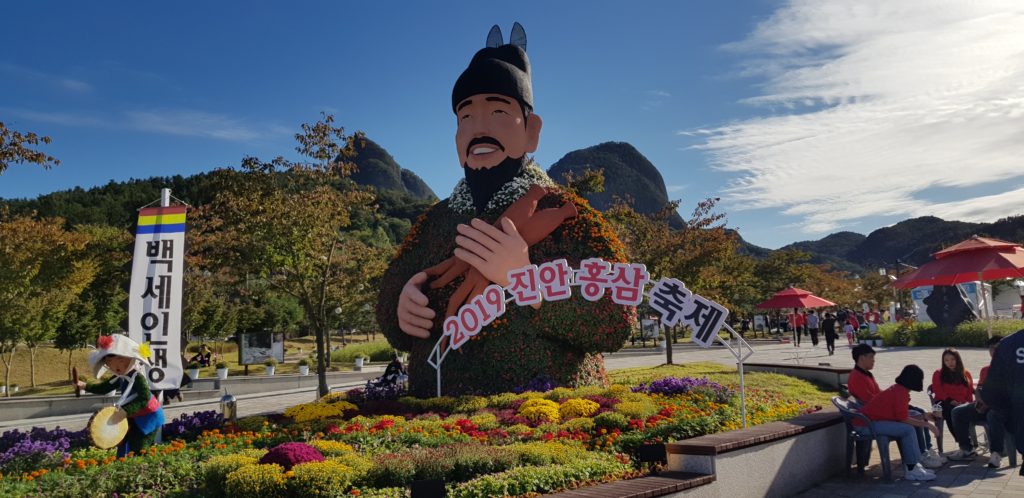
If you’re traveling in October, try to time your visit to Jinan during the Jinan Red Ginseng Festival (9-13 October in 2019). If you’re lucky you can catch a performance from a K-Pop group, but even if you visit on a non-festival day a visit to the town is worth it to sample red ginseng products and local specialties.
Day 12 - Jirisan National Park, Seodo Station, Gwanghallu Pavilion, Namwon
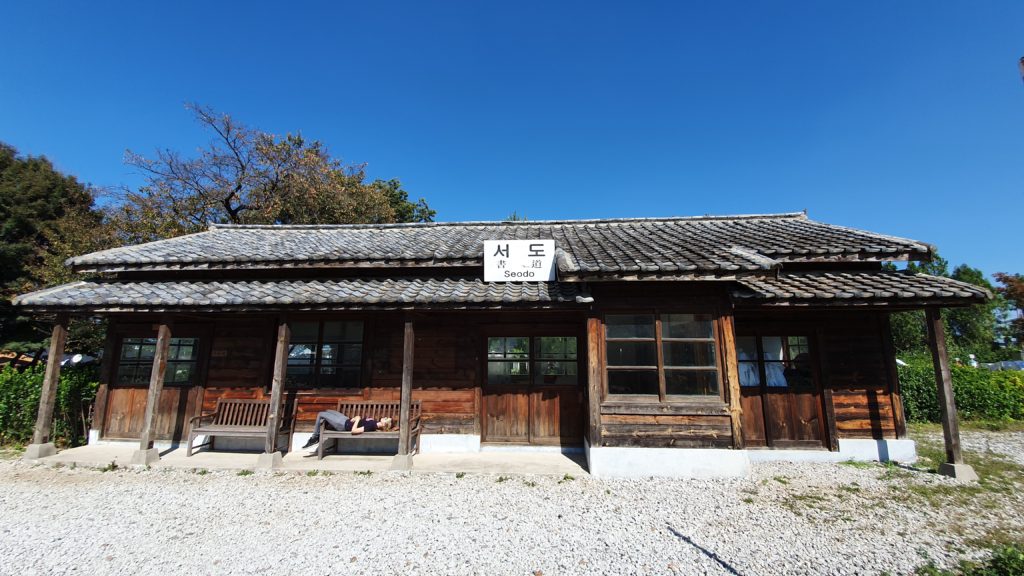
Go hiking in Jirisan National Park. You can go for an all-day hike (or overnight) or just sample Jirisan by driving through the Cheoneunsa-Seongsamjae Course and do the Nogodan Course (an easy one hour and fifteen minutes hike).
After a morning hike or as an alternative day program, head to Seodo Station, just north of Namwon, to visit the filming site of the 2018 K-Drama Mr. Sunshine.
Back in Namwon (because you have to visit the city you stay in after all), head to Gwanghallu Pavilion, known for the Korean folk tale Chunhyangjeon.
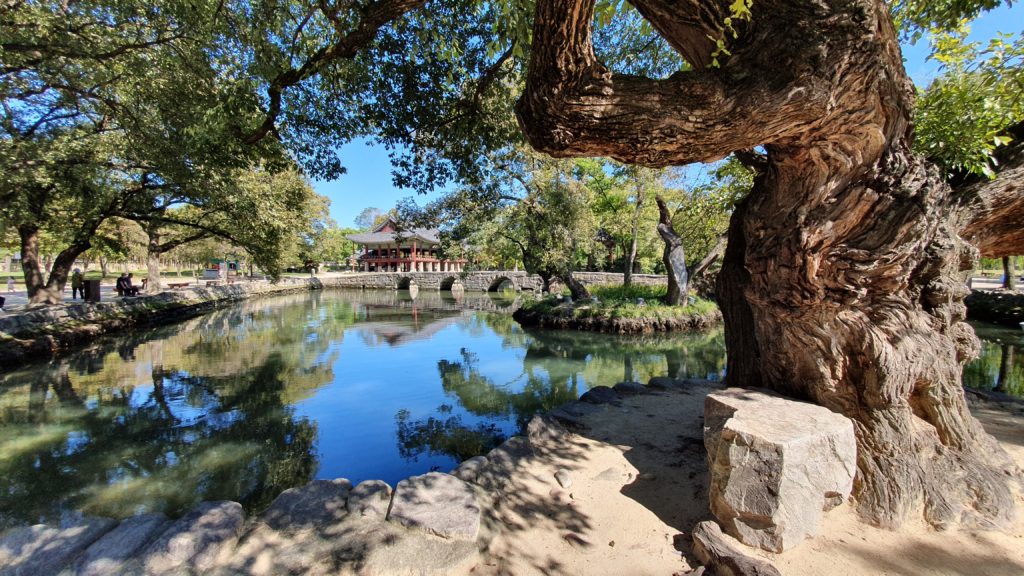
If you like museums, Kim Byeong Jong Museum (남원시립김병종미술관) is recommended. The architecture of the building is interesting because of the way it uses space and overflowing water. When I visited during the Sound of Namwon festival in 2019, there was an exhibition about sound. Even though there were only three galleries and therefore not much to see, the exhibition was worth it and reminded me of the sound of the flowing water outside the building and the sound of wind catchers in the shape of colorful insects catching the wind.
If you’re visiting in October when the lantern festival hits Jinju (1-13 October in 2019), then head to Jinjuseong Fortress in Jinju to join the festivities. It was one of the more interesting festivals I visited in South Korea with its many colorful lanterns in many forms, the illuminated Jinjuseong Fortress and good food stalls next to the river. During the festival, you can also visit the fortress and observe the fortress wall, temple and pagoda on top of the hill.
Where to stay in Namwon
I stayed at Namwon Hotel because I got charmed by the picture of the hotel surrounded by nature. In reality, the building looked a bit worn, but the owner was a really nice man, making us free breakfast every morning (fried egg, apple, steamed sweet potato and toast). This hotel is near Jirisan and Maisan Provincial Park.
Boseong - day 13 - 14
Day 13 - Damyang/Gwangju or Gwangyang/Suncheon or Yeosu/Dolsando
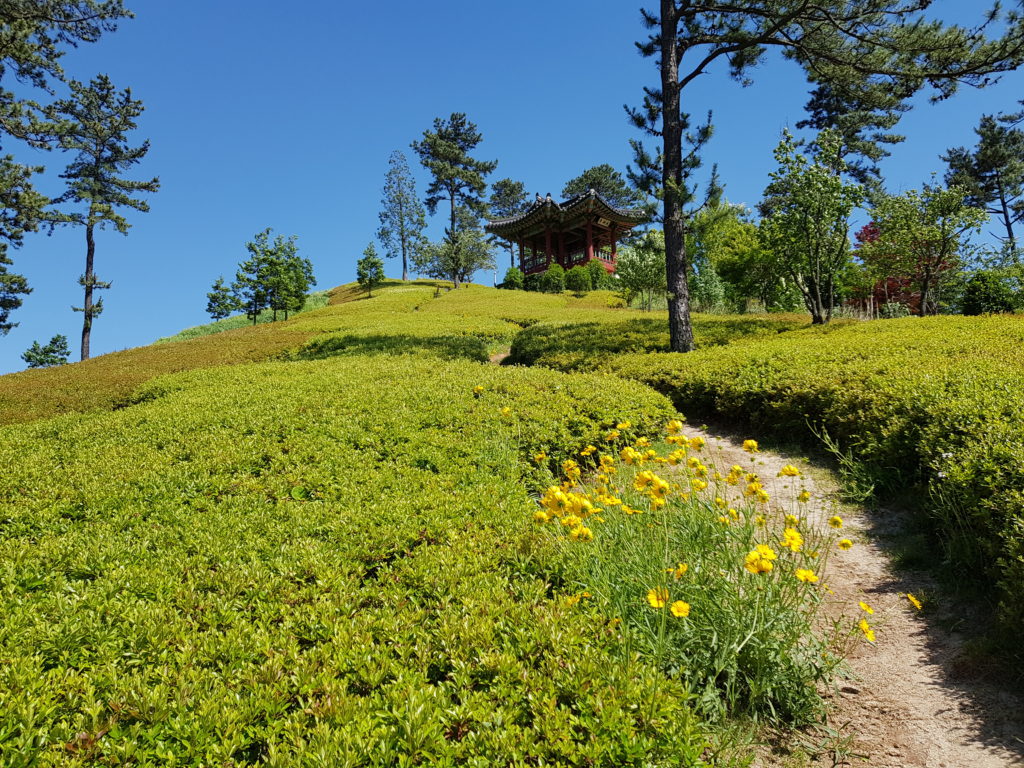
If you have never been to this area before, you have a very interesting choice to make.
- Go to Damyang and Gwangju to visit Juknokwon Bamboo Forest in Damyang and the Student Uprising monument in Gwangju.
- Go to Gwangyang and Suncheon to visit Gubongsan Observatory, Suncheon Drama Film set and Suncheon Bay National Garden and Wetland Reserve.
- Roadtrip to Yeosu and Dolsando (more practical if you are staying in Suncheon or Gwangyang than Boseong)
See my Highlights of South Korea travel itinerary day 12 – 15 for more information about the above.
Day 14 - Goheung peninsula, Jeokgeumtto Island, Naenarodo Island
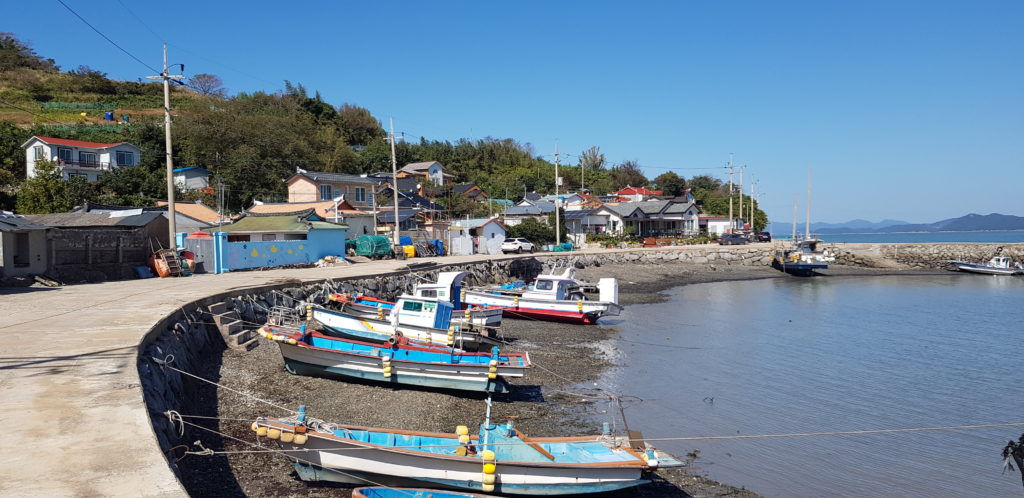
It’s time to explore one of the lesser-known peninsulas in South-Korea: Goheung. Unspoiled by tourism, the fishing and farming industry seemingly unbothered by the fast-moving world further north, in other words: a very unique place to visit, so go there before it’s too late.
Start your road trip with a visit to the fishing village on Jeokgeumtto Island. There is a bridge going from Goheung to Jeokgeumtto but it’s not yet visible on Google Maps. Once the bridges connecting Goheung to Yeosu peninsula are finished, this area will become really interesting (and attract more tourism) as you can also visit the islands in between. But already the fishing village with its decorated houses and the small road around the island not yet optimized for vehicles is worth a visit.
Going back to the east side of Goheung, you can visit Yeongnam Yongbawi (영남용바위) rock area to see the cliffs shaped by the seawater over time and, if you’re lucky, see the locals in action fishing and looking for shellfish.
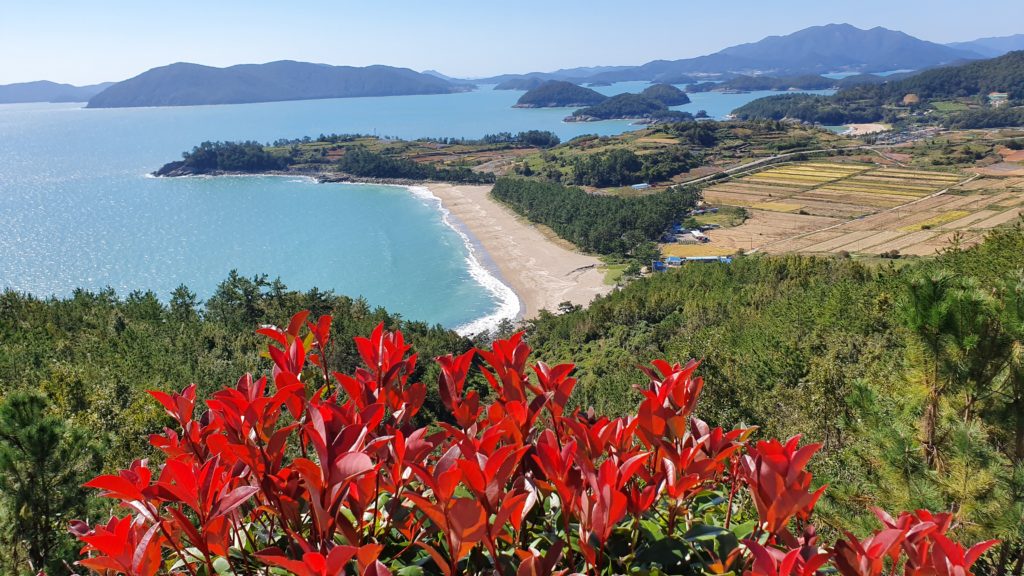
Nearby is Goheung Observatory (고흥우주발사전망대) with a rotating cafe on the top level providing a great view of the many small islands in the sea surrounding Goheung peninsula.
Continue the road trip towards Naenarodo Island while observing the peaks of Paryeongsan Mountain and the colorful murals on the walls in Yeongnam-myeon village.
On Naenarodo Island you can find a cafe (하얀노을카페) with a brilliant view of the islands in the area and an open terrace which is perfect for relaxing while watching the sun go down in the ocean.
Where to stay in Boseong
I stayed in a two-bedroom villa with a terrace at Chungnokdang, a traditional Korean house in Boseong surrounded by tea fields. It was a very beautiful area to just wander around and relax a bit. The tea plants higher up are not well-maintained at all: I see a job opportunity there. The lady of the house does use the lower region to make her own tea. Breakfast was great (many side-dishes) and the hosts were very nice. This traditional house was of better quality (better hygiene, better maintenance) than the one Nongamjongtaek I stayed at last year in Andong. But the one in Andong felt more relaxing because the area surrounding it was more nature than village and there was more space for simply hanging out and relaxing for a day.
Wando - day 15 - 16
Wando is an island in the southern part of the country, connected to the mainland by a bridge. It’s most famous for Cheonghaejin; the headquarters of Jang Bogo who dominated the sea routes in the Yellow Sea in the ninth century.
Day 15 - Boseong Tea Plantation, Gangjin Bay Ecological Park, Cheonghaejin, Jang Bogo Statue, Wando Tower
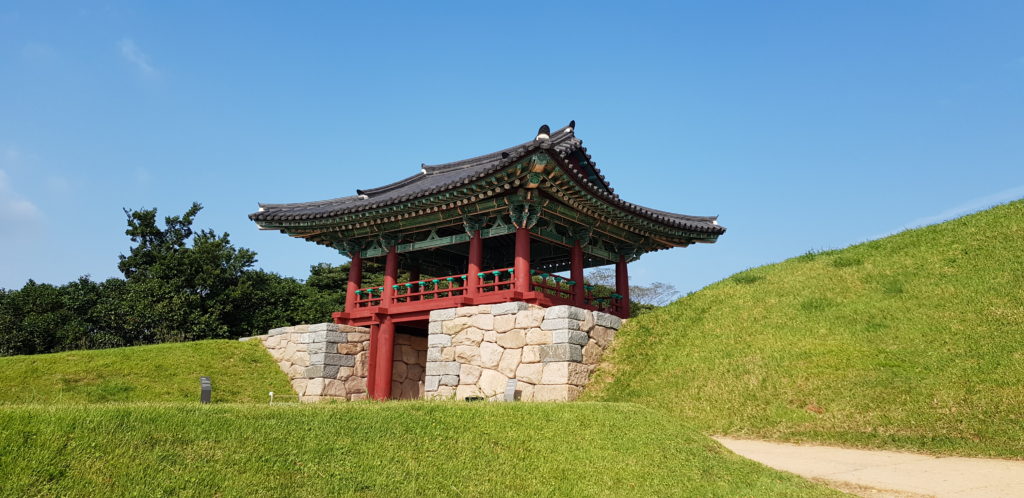
Pay a visit to Daehan Dawon Tea Plantation in the morning. If you’re visiting in May, see if you can plan your visit around the annual tea festival. You can walk around the tea fields and even go up for a very nice view of the surrounding area. Don’t forget to sample and buy some tea at the tea museum/store.
The next stop is Gangjin Bay Eco Park. This park, with the parking lot completely covered by solar panels, very much resembles Suncheon Wetlands, but then without tourists. You can walk on the boardwalks in between reed and water with mountains in the background and take all the pictures you want!
After entering Wando, you can find Cheonghaejin island on the eastcoast. You can visit the island by crossing the bridge that connects it to the bigger Wando on foot. On the island, you can see many historical sites related to general Jang Bogo. It basically feels like you’re on your own paradise island and it isn’t hard to imagine the Koreans of the past used this island as a naval base.
Back on Wando, not far south of Cheonghaejin, you can see the Statue of Jang Bogo on top of a building resembling a ship.
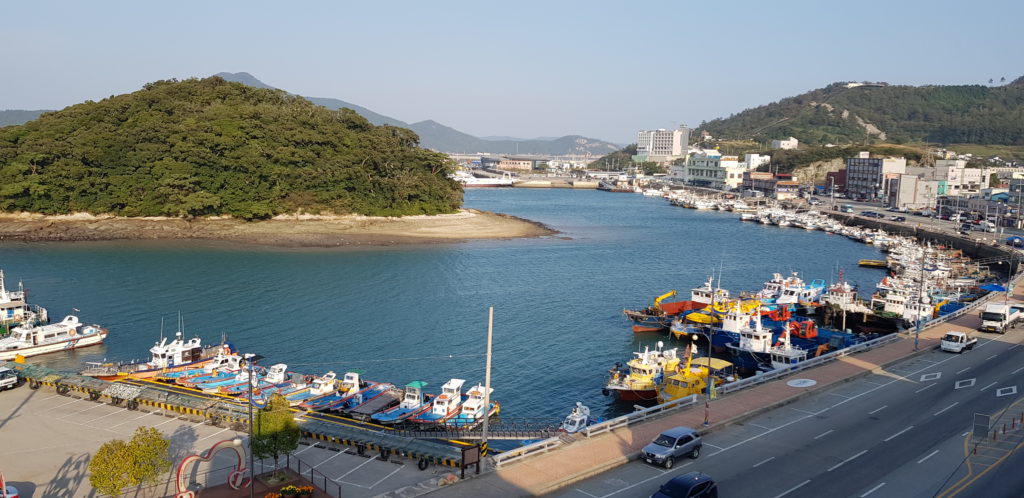
In the afternoon and evening, you can explore Wando town and head to Wando Tower when it gets dark to see the illuminated tower and city.
I also highly recommend a visit to Wando’s Sea Algae Center in the harbor of Wando before 6 pm: the visual representation inside the museum is beautiful and there are English movies about the different types of seaweed and abalone cultivated on Wando and the surrounding islands. On your visit to Bogildo tomorrow you will see many seaweed farms and if you look closely you can spot abalone processing shops in Wando town.
Day 16 - Bogildo Island: Yunseondo Grove, Nakseoje, Goksudang, Manggeut observatory, Yesongri observatory, Song Si-yeol rock
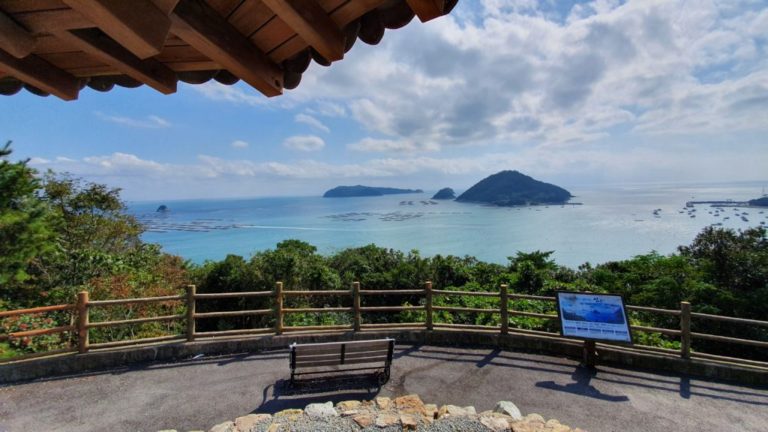
Head to Hwaheunpo Port on the western side of Wando to take a ferry to Bogildo, also called the most beautiful island in Wando, just 12 km off the coast of South-Korea. The whole island is a maritime national park, wrapped in evergreen forest and high rising hills.
The ferry itself is the first attraction: join the locals and lie down on the heated floor for the duration of the fifty-minute journey to Dongcheon port on the island Nohwa (Nowhado).
The most well-known site to visit on Bogildo is Yunseondo Grove, a secluded garden in the center of the island with the representative pattern from the Joseon dynasty.
Nearby you can also visit the traditional houses and library Goksudang and Nakseojae.
By taking the road on the western side of the island you can reach Manggeut Observatory and Book-ri Dinosaur Egg Fossils Beach. From the observatory, you have a good view of the coastline of Bogildo and of the surrounding islands. The Dinosaur Egg Beach is a very good place for some pictures of the sea standing amidst the egg-shaped stones on the beach.
On the eastcoast of Bogildo you can stop for a picnic (bring your own lunch!) at Yesongri observatory while watching the harbor with fishing boats and seaweed farms. This is a very nice spot.
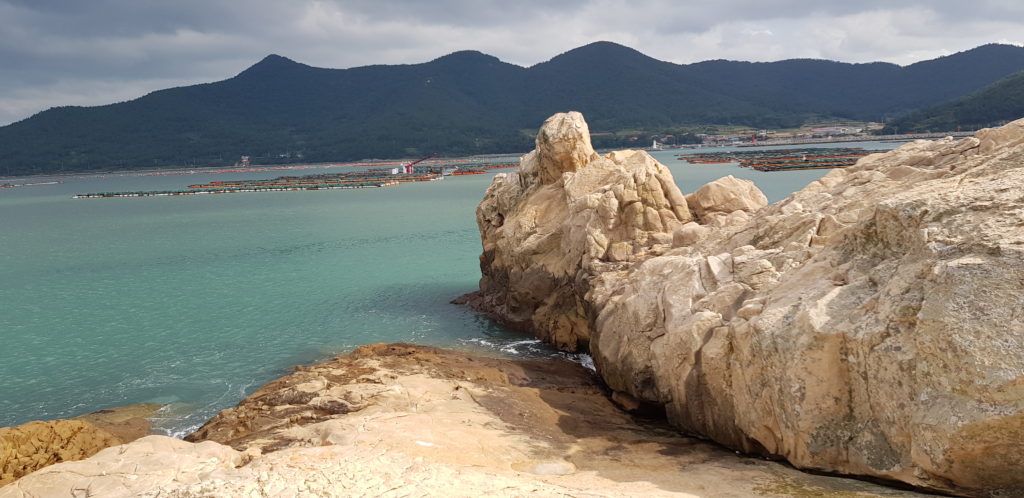
Also on the eastern side of Bogildo you can visit Song Si-yeol writing rock to see the poem written on the rock. I was very lucky with the weather on this part of my trip: the sky was growing dark, but the sun was still shining and the yellow rocks of the cliff were illuminated against a very bright blue/green sea. In other words: the view here is beautiful.
Some practical tips: when I visited none of the restaurants and cafes on Bogildo (if any) were open. So make sure to bring provisions. Across the bridge, in Nohwa’s Imok port, you can find many restaurants and cafes.
The ferry to and from Bogildo operates once every hour; the first one from Wando at 07:00 and the last one returning at 17:20 (timetable of October 2019).
Where to stay in Wando
I stayed at Wandonesia, a hotel near the harbor, offering a nice view of said harbor from the rooftop terrace. It’s a place I would recommend for whoever visits Wando: spacious rooms, nice hosts, good location. The cozy cafe on the first floor serves bagels with coffee or tea for breakfast (included). Only one thing to keep in mind: there is no elevator taking you to the rooms on the 3rd-5th floor.
Mokpo - day 17 - 18
Mokpo is a city in the southwestern part of South Korea, surrounded by islands serving as a protective barrier for the city against the sea.
Day 17 - Dadohaehaesang National Park, Haesin Cheonghaepogu Filming Set, Dosolam Hermitage, Duryunsan Mountain
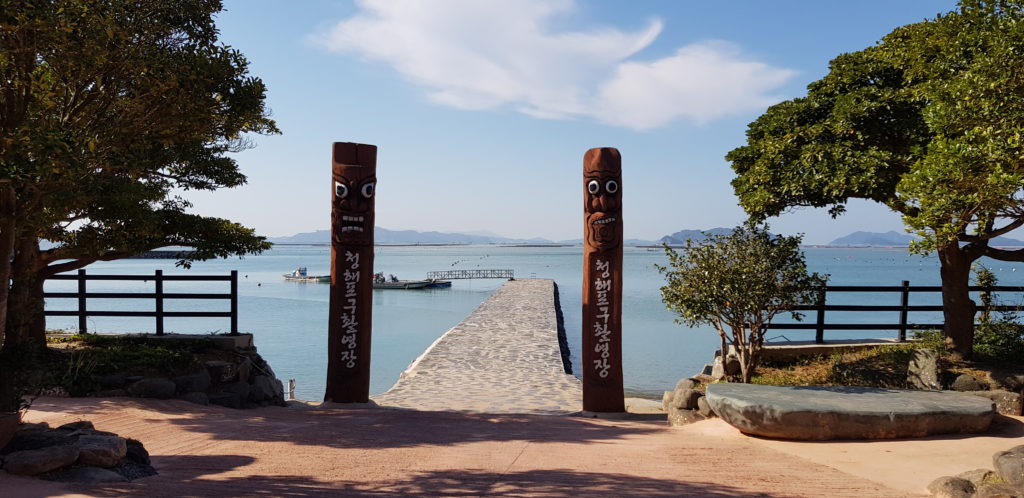
In the morning you can pay a visit to the southern coastline of Wando for a stroll along the coast in Dadoheasang National Park.
From there, head to Haesin Cheonghaepogu Filming Set to watch the reconstructed (pirate) village where many films and series were shot. For example Haesin, Chuno, Rookie Historian Gu Hae Ryung and many more.
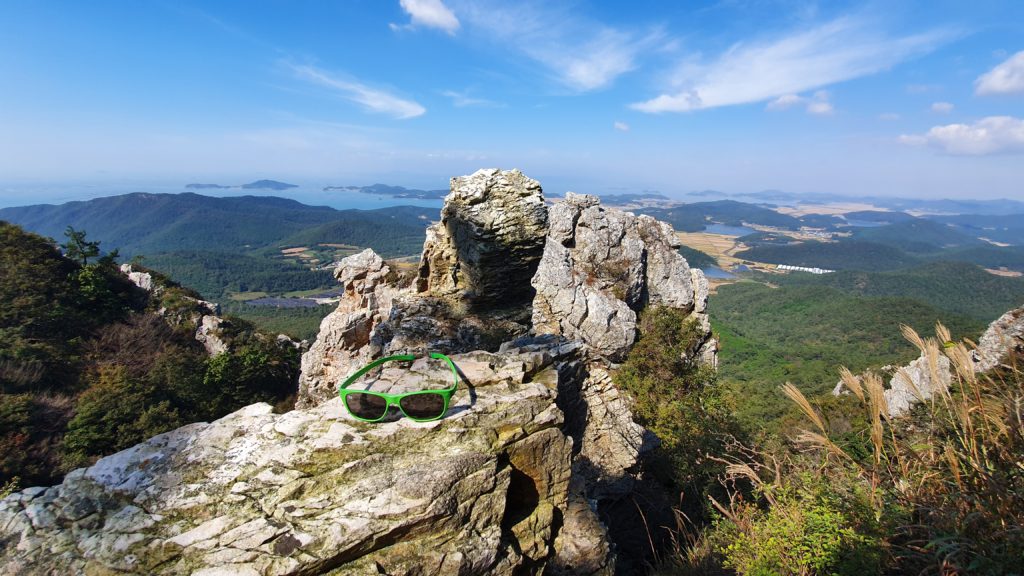
The next stop is Dosolam Hermitage on the mainland (west of Wando). With a walk of less than half an hour from the parking lot, you have a beautiful view of the rocky mountains and the surrounding area.
From there drive towards Haenam for a visit to Duryunsan Mountain. You can take the cable car or hike for 2-3 hours to reach the top for a beautiful view of the surrounding area, including Duryunsan’s eight peaks and if you are lucky, Hallasan on Jeju. In the provincial park, Duryunsan is part of you can also find many temples and traditional houses surrounded by mountains and trees if you follow the road south.
Afterward, head to your hotel in Mokpo. In the evening you can explore Pyeonghwa Square and see Mokpo Love Gate. For dinner or a drink, you can take a stroll over the Street of Roses.
Day 18 - Jeungdo Salt Farm, 1987 Filming Set, Gatbawi Rock
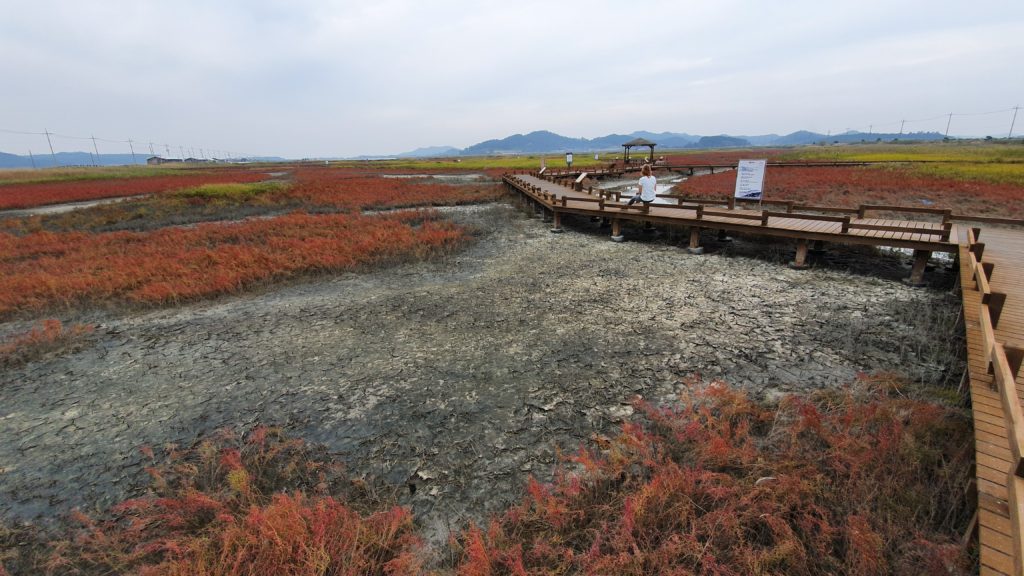
Today’s main attraction is Jeungdo Salt Farm and to get there you have to drive north of Mokpo towards Muan-gun and Sinan-gun. In Muan you can observe the Muan Red Clay Mud Flat and the vegetable farms on red clay before reaching Jeungdo Island via Saokdo Island.
Jeungdo is known for its Salt Farm and the related Salt Museum, Sea Salt Ice Cream and Salt Mirrors but my highlight of the day was Taepyeong Yeomsaeng Botanical Garden. In the botanical garden, you can see halophyte plants, a salt-tolerant plant with a reddish look that grows in soil of high salinity. Also present are the crabs and mudfish, famous for being the main ingredient of Chueotang (mudfish soup).
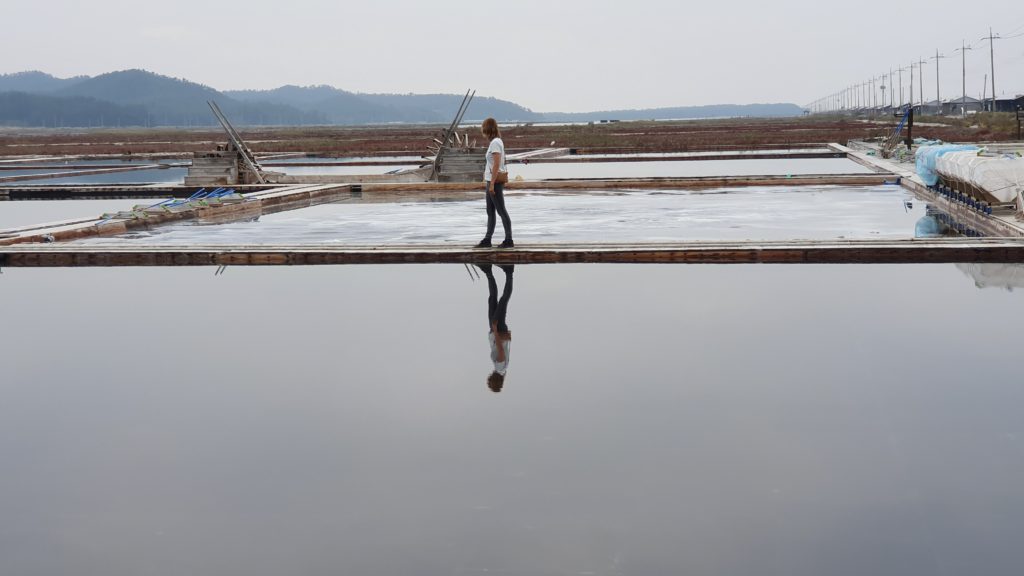
Cross the road after leaving the garden to watch the actual Salt Farms and take a picture using the salt farm as a mirror.
You can visit the Salt Museum in the old salt warehouse and watch the Superpower of Salt movie (in English) to learn more about the importance of salt. It is kinda long but as the rest of the museum is pretty much Korean only, this is the only information you will get.
Opposite the museum, you can buy salt souvenirs at the shop (big, bigger and huge sacks of salt) and try a Sea Salt Ice Cream with topping. Beware of the Mala topping: ginger, red pepper and garlic really don’t mix well with ice cream; I wish I had chosen fruit or matcha flavor instead. But give it a try if you feel adventurous.
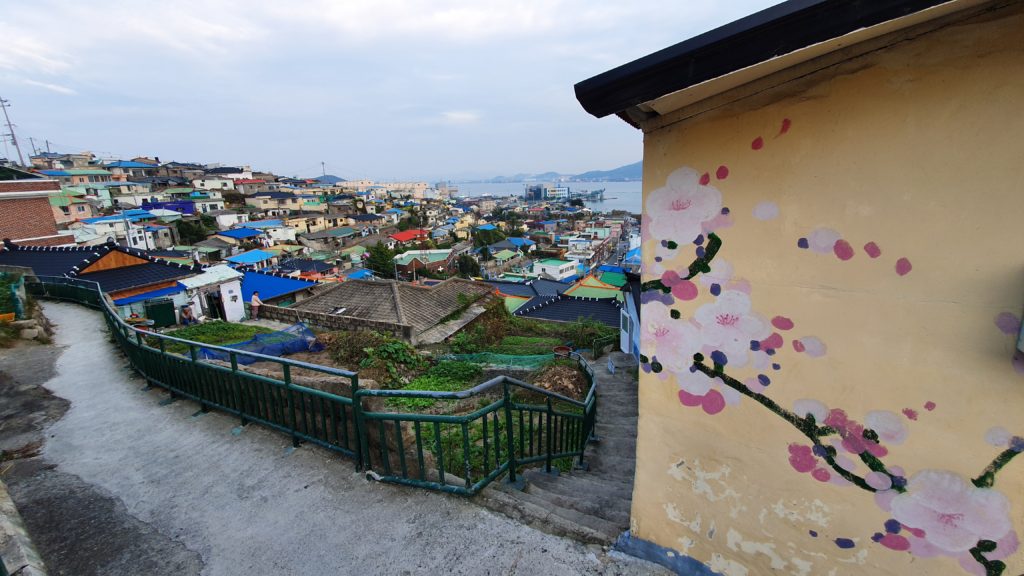
In the afternoon you can visit the Film Set for the 1987: When the day Comes movie that was very popular in South Korea. You start at the bottom of the village that very much resembles villages like Busan’s Gamcheon Culture Village and Jeonju’s Jaman Mural Village. The shop that was used in the movie is right at the entrance. If you’re lucky, the shop is open and you can look inside and see the interior that was used in the movie. Take the stairs and wander around in the village, have a drink together with the locals in one of the cafes and enjoy the mural art.
Make one last stop on your way to your hotel at Gatbawi Rock, a natural sandstone and tafoni formation on the coast of Mokpo with a very interesting shape.
1987: When the Day Comes
In January 1987, a 22-year-old college student dies during a police interrogation. Under the orders of Director Park (Kim Yoon-seok), the police request the body to be cremated in order to destroy evidence. Public Prosecutor Choi (Ha Jung-woo), who was on duty on the day of the incident, denies the request and calls for an autopsy.
Interested? Check it out on Amazon.
Where to stay in Mokpo
I stayed at Charmant Hotel, because it was one of the hotels with the best reviews and a good price. Nearby the hotel you can find the Street of Roses with many restaurants and cafes.
Boryeong - day 19 - 20
Day 19 - Chaeseokgang Cliffs, Gogunsan Islands, Daecheon beach
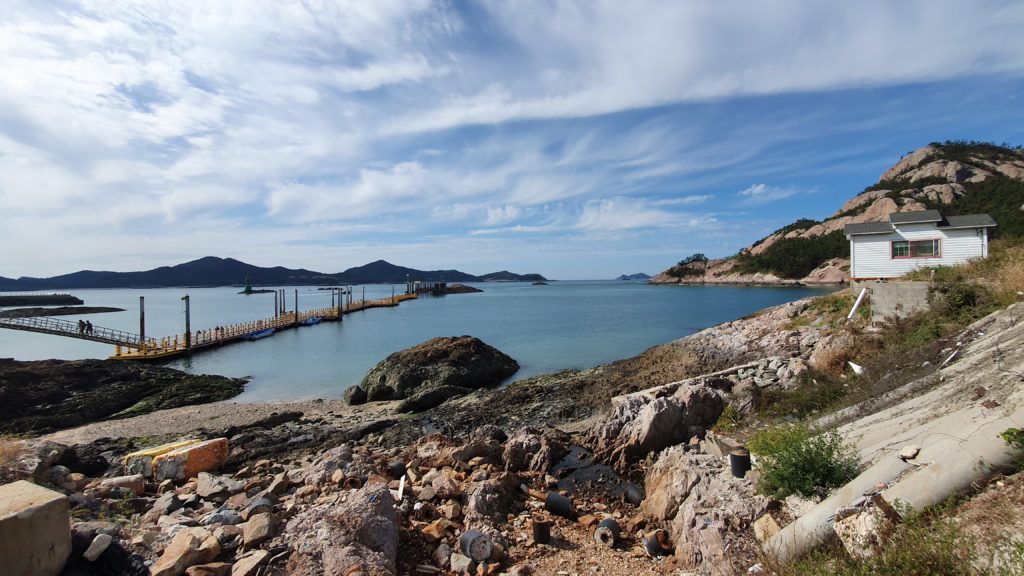
The first stop today is Chaeseokgang Cliffs in Byeonsanbando National Park to see the stone cliffs and take a walk along the coast.
From there take the man-made seawall to the Gogunsan Islands, also dubbed by me: the Lofoten of South Korea. The seawall first takes you to Sinsido Island from where you can follow the bridges to Munyeodo Island, Seonyudo Island and Jangjado Island to admire the view of these rocky islands surrounded by sea. Seunyudo is also a good place to have lunch in one of the restaurants and to spend the afternoon as the scenery is beautiful.
After exploring the islands, drive on to your next hotel in Boryeong. For dinner, you can pick any of the restaurants near Daecheon beach and try your hands at grilling clams and other seafood (even the occasional pork belly) or try the still moving baby octopus sashimi. Fortunately for some tourists, many restaurants offer both fish and meat.
Day 20 - Buyeo, Daedunsan National Park
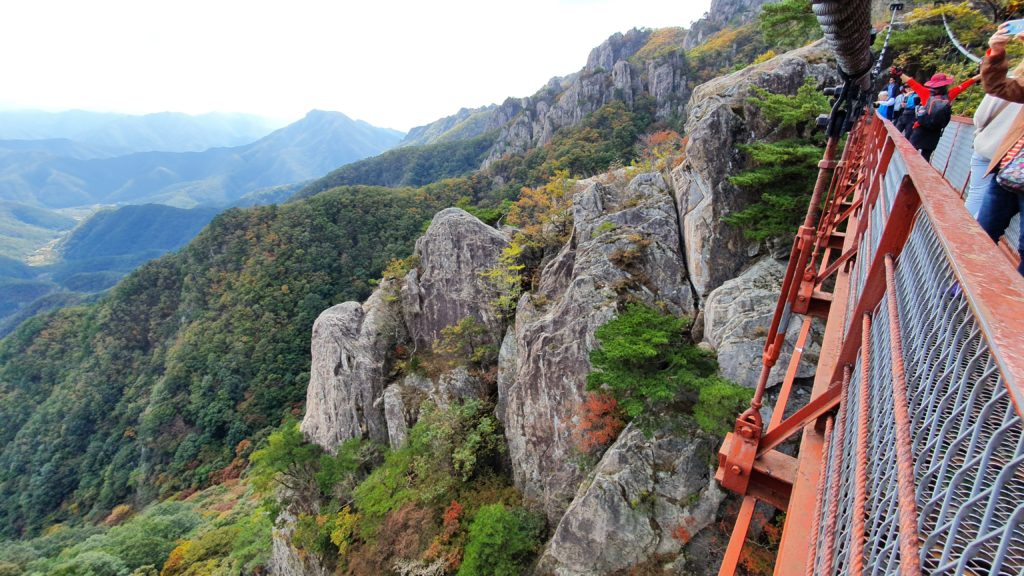
This morning starts with a visit to Buyeo to visit the many historical sites in the area. A few of the must-see places are Busosanseong Fortress and Nakhwaam Cliffs overlooking the river and Gungnamji Pond. If you visit the Pond out of season then the area around the pond will look like a wasteland directly taken from a sci-fi movie (and perfect for Halloween). Most of the lotus flower plants were dead when I visited, but other types were just starting to bloom.
If you like exhibitions you can go to the Baekje National Museum.
Drive another hour east to Daedunsan National Park and take a cable car up the mountain; one of the best cable cars in South Korea! This park is really beatiful in autumn when the leaves start to turn red. The cable car helps you big time, but you still need to climb some stairs and rocks to reach the hanging bridge (Geumgang Gureumdari), stretching 50 meters between Imgeumbawi Rock to Ipseokdae Pedestal for a beautiful view of the area. Walk a bit further to get to the red stairs, perhaps the best-known visual representation of Daedunsan National Park and also a very impressive steep climb (but easy because you have handholds on both sides).
Where to stay in Boryeong
I stayed at Nova Motel near Daecheon beach and many restaurants. It was not a very interesting place to stay at (it had rooms with round beds which are very inconvenient for two people) but I don’t have anything bad to say about it either. The location is very convenient.
Suwon - day 21
Day 21 - Suwon Hwaseong Fortress, Seojangdae, Hwaseong Haenggung, Haenggung-dong Mural Village, Padalmun Gate, Pavilion
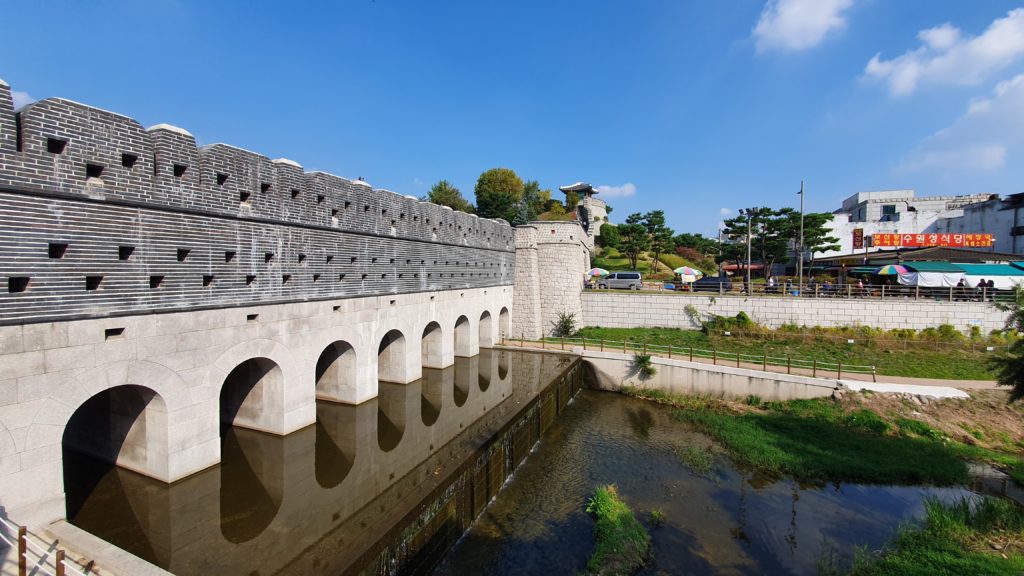
The city of Suwon is best known for Suwon Hwaseong Fortress. A good start would be to head to Janganmun Gate and follow the trail south along the wall admiring the reconstructed historical buildings until you get to Seojangdae Commanding Post.
Leave the fortress in the south and head east to Padalmun gate, one of the four big gates of Suwon Hwaseong. The area around the gate and Yeongdong Market is ideal for buying some snacks or lunch during a day full of history.
Follow Haenggung-ro to visit Hwaseong Haenggung, a temporary palace where the royal family retreated to during a war. In Haenggung-ro you can see many interesting shops and mural art. This is also the street the dressed-up royal guards with musical instruments take from the palace.
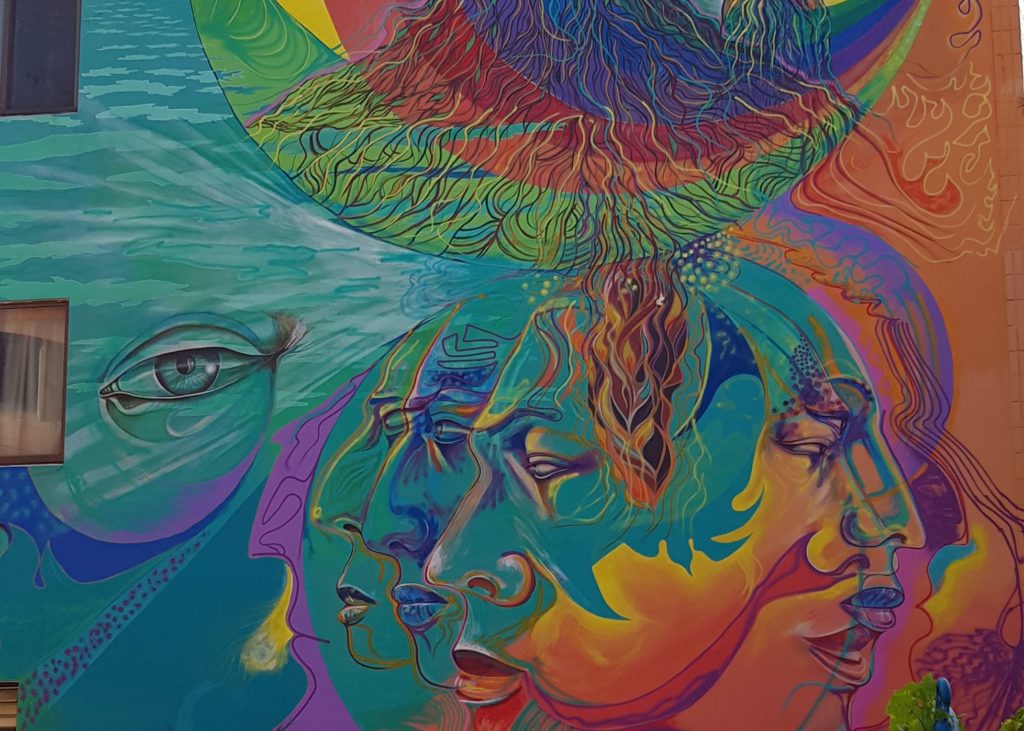
Your next stop is Haenggung-dong Mural Village. There are only a few streets, but the paintings on the walls are impressive. End your historical tour in Suwon with a look at Banghwasuryujeong Pavilion.
For diner, I recommend heading to Hyanggyo-ro near Suwon train and subway station. There are many fun restaurants here and this area really comes to life at night.
Where to stay in Suwon
I stayed at Malu Hotel, near a bus line to Padalmun Gate and other places I wanted to visit. The vibrant restaurant area Hyanggyo-ro lies within a few minutes walking distance of this hotel. A stay at this hotel is recommended if you like warm hotel rooms: when you take out your room key, the room automatically heats up to 27 degrees Celsius. I like warmth very much, but even for me this was too much.
Time to fly home. Unless you have the luxury to add some more days to explore Seoul after this. Check out the must-see places in Seoul in my Seoul 7 days itinerary.
I hope I left you with plenty of inspiration for your own trip to South Korea! Let me know how it was.
Practical Information
Time your South Korea visit well
This journey is possible year-round but works best in spring and fall to avoid hot summers (monsoon) and cold winters (driving in the snow).
Tip: keep in mind that many places like museums are closed on Mondays and/or Tuesdays. Avoid public holidays like Chuseok unless you specifically want to join the celebrations.
Transport and navigation
This itinerary uses a rental car to travel between cities.
Navigating in South-Korea is easy. You can use Naver maps (Android / iOS) to find optimal driving and walking routes. When using a car navigation system, search for destinations by entering their telephone number (easy to find with google maps).
Itinerary budget
The costs depend on your budget. If you choose to use mid-range hotels your journey will be more expensive than when you stay in hostels. Likewise, if you rent a car it matters if you are a solo traveler bearing the costs alone (but lower total costs because the car can be smaller) or travel with family or friends and can share the costs. You can eat in expensive restaurants every day or buy some cup ramyun in a convenience store. Eating out in South Korea is not expensive, but certain meals are, like when you want to eat prime quality abalone or sashimi.
The costs listed below are based on comfort, but not too luxurious. By choosing cheaper hotels or motels (still with a private room and personal bathroom) in cities and more expensive traditional houses in rural areas you can adjust the costs as you like and still keep the average accommodation costs per night affordable.
Transport
- Retour flight from your hometown to Seoul: costs depend on where you live
- Hiring a car (22 days): around 1400 EUR (1545 USD) for a mid-range car (for 3-4 persons). The total price of the car will be around 1000 EUR if you travel alone or with a party of two because you can rent a smaller car.
- Gasoline: around 320 EUR (357 USD) in total for over 3000 km.
- Toll road fees: around 20 EUR (22 USD) in total
- Public transport: buying a public transport card and loading it with the fare for the occasional bus or subway trip: 10 EUR (11 USD) per person
- Ferry to Bogildo: 60 EUR (67 USD) retour costs for three persons and a car
Food
- Around 30 EUR daily per person for 22 days: 660 EUR (729 USD) per person
Accommodation
- Around 40 EUR daily per person for 22 days based on a mix of traditional houses and motels: 880 EUR (971 USD) per person
Wifi
- 45 EUR (49 USD) in total for 22 days. I always order via Klook.com as they offer the cheapest pocket wifi I can find for many Asian countries.
Various costs like entrance fees and cable cars
- Around 50 EUR (56 USD) per person.
Souvenirs
- As much or as little as you want
Keep in mind that this is just an estimation based on the trip I did in October 2019. It cost me around 2200 EUR (2453 USD) per person for a party of three, including all the above, but excluding international flights and souvenirs.
If you do this trip on a budget (cheaper hotels and food) the total cost will be much lower.
What to read when visiting South Korea
Find out about the best Korean books with an English translation.
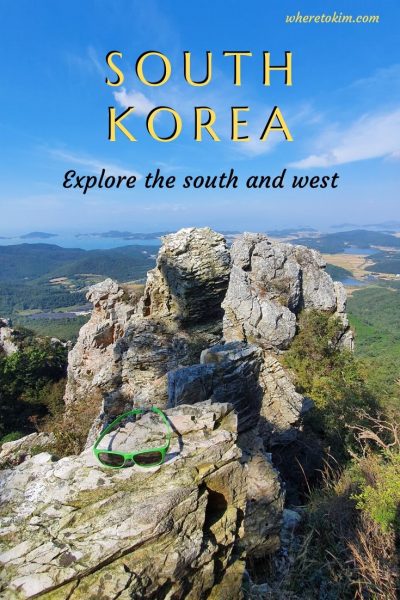

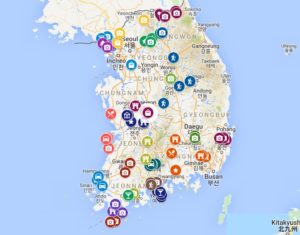
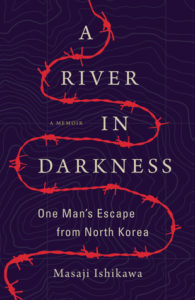
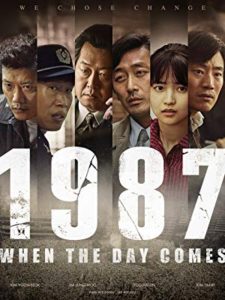






Beste Kim,
Ik heb je blog pas kort geleden ontdekt en haal er heel veel informatie uit voor mijn komende reis. Ik ga in september door ZK reizen voor 1,5 maand. Ik lees heel veel op je blog over Jirisan National Park in Zuid-Korea. Ik wil heel graag naar Jirisan National park (ik ga al naar Seoraksan), maar geen enkele site is duidelijk hoe ik hier moet komen, welk openbaar vervoer en waar de verschillende trails beginnen. Ik dacht eraan 2 dagen in Namwon of Gwangju te zitten en vanuit daar naar Jirisan. Maar als ik niet weet hoe ik het park binnenkom, wordt dit natuurlijk lastig. Zou u mij hier meer informatie over kunnen geven?
Ik hoor het graag,
Met vriendelijke groet,
N. St
Hi!
Wat leuk dat je anderhalve maand gaat rondreizen in Zuid-Korea. Zelf heb ik alles met de auto gedaan dus ik weet niet veel over OV.
Wel heb ik toen gezien dat Gurye een goed uitgangspunt is voor trails in Jirisan. Vanaf de Gurye Bus Terminal kun je een bus nemen naar Seongsamjae Service Area vanwaar veel trails starten. Timetables zijn voor zover ik kan zien alleen op Koreaanse sites beschikbaar. Ik weet niet of je daarmee uit de voeten kunt? Op de site van Gurye kun je een timetable downloaden (eerste downloadknop). Kijk daar voor 노고단 노선 voor de bus naar 성삼재. Hij lijkt om 9 uur en 14:20 uur te gaan en duurt een uur.
Groet,
Kim